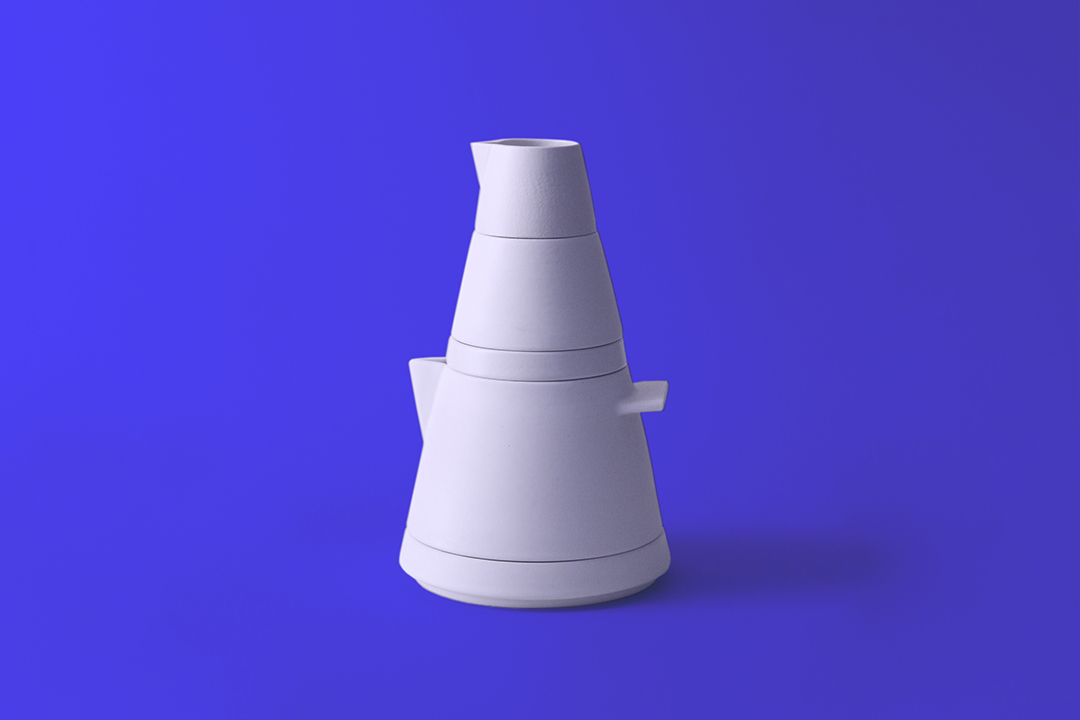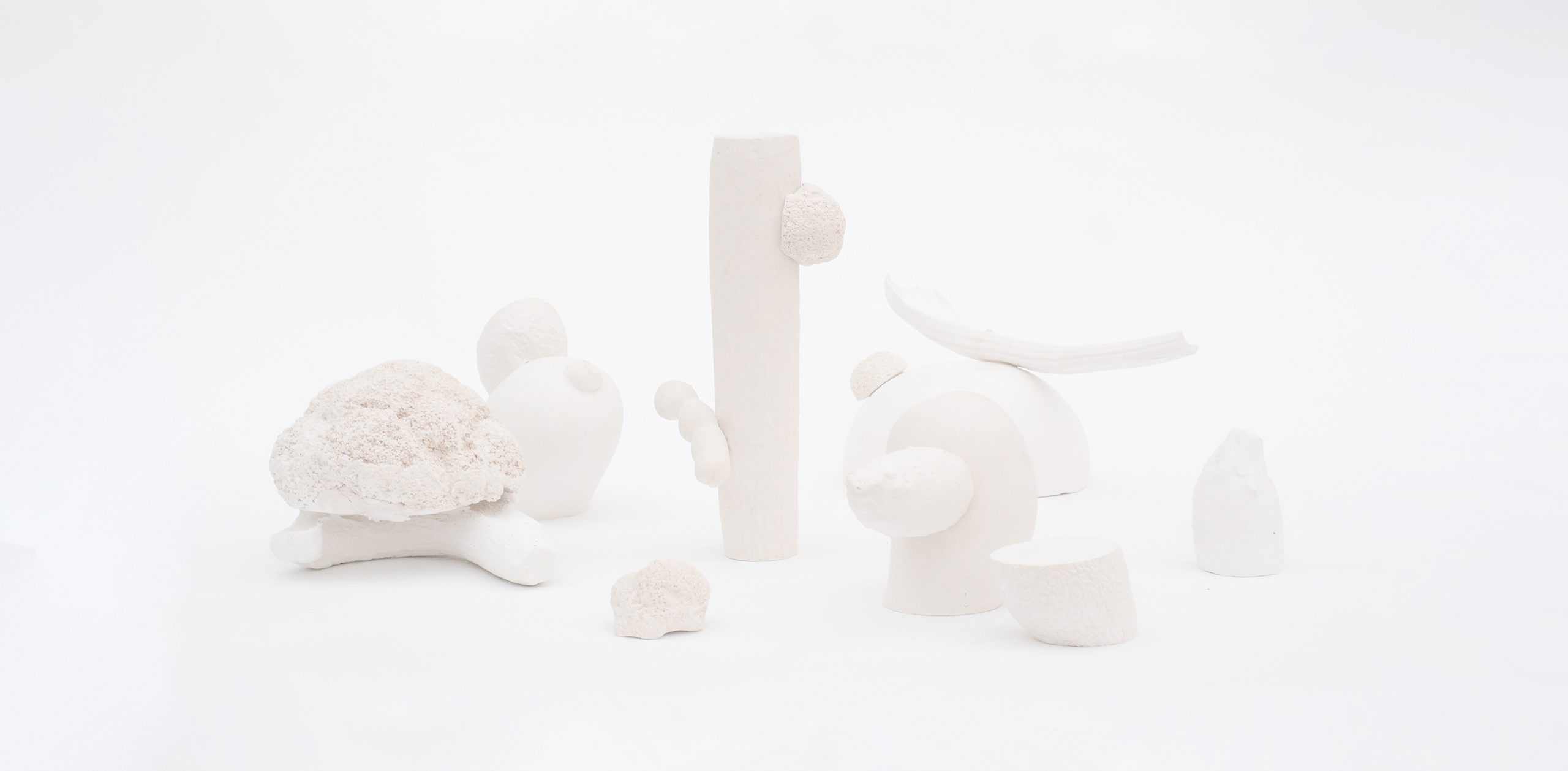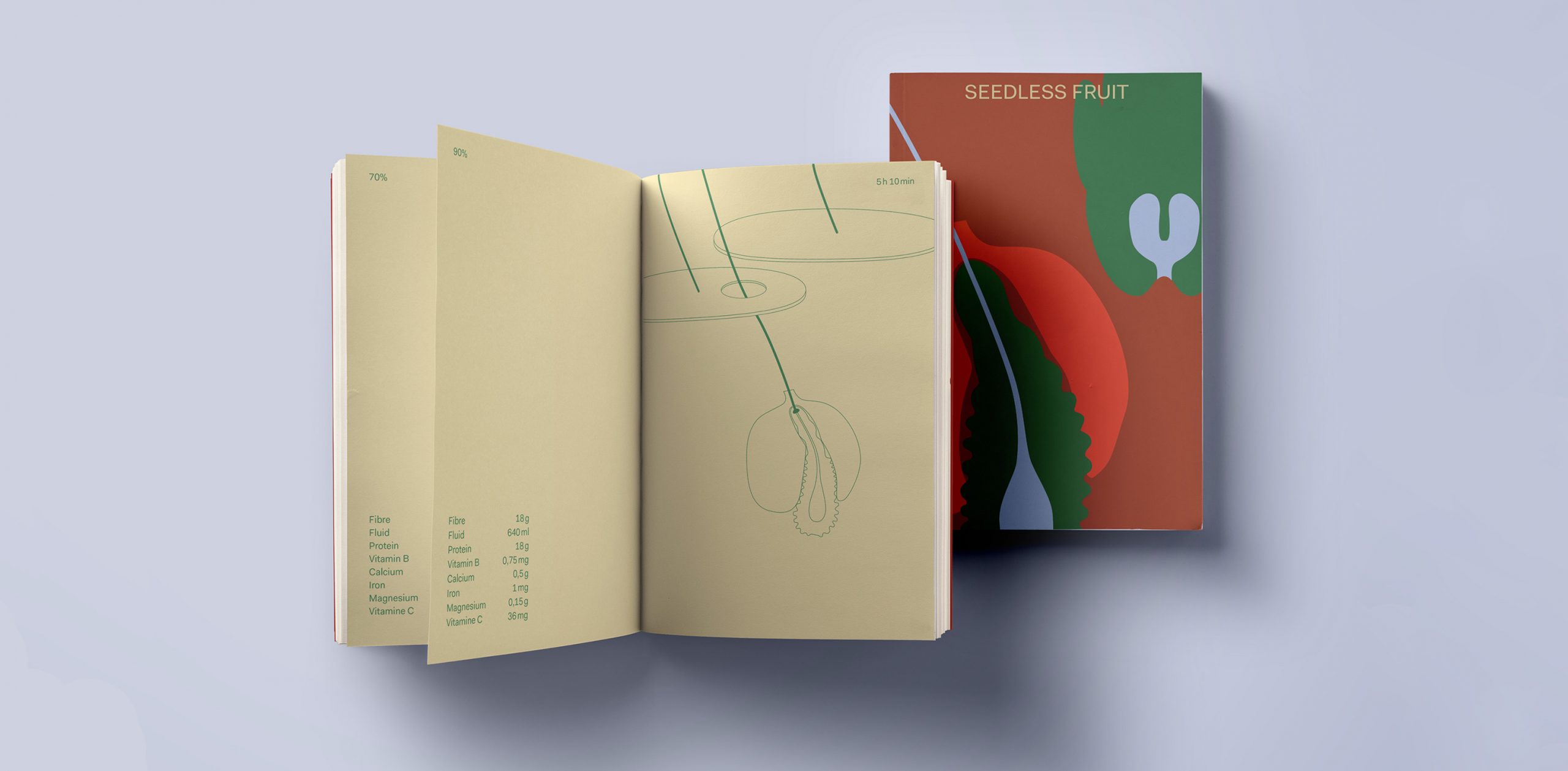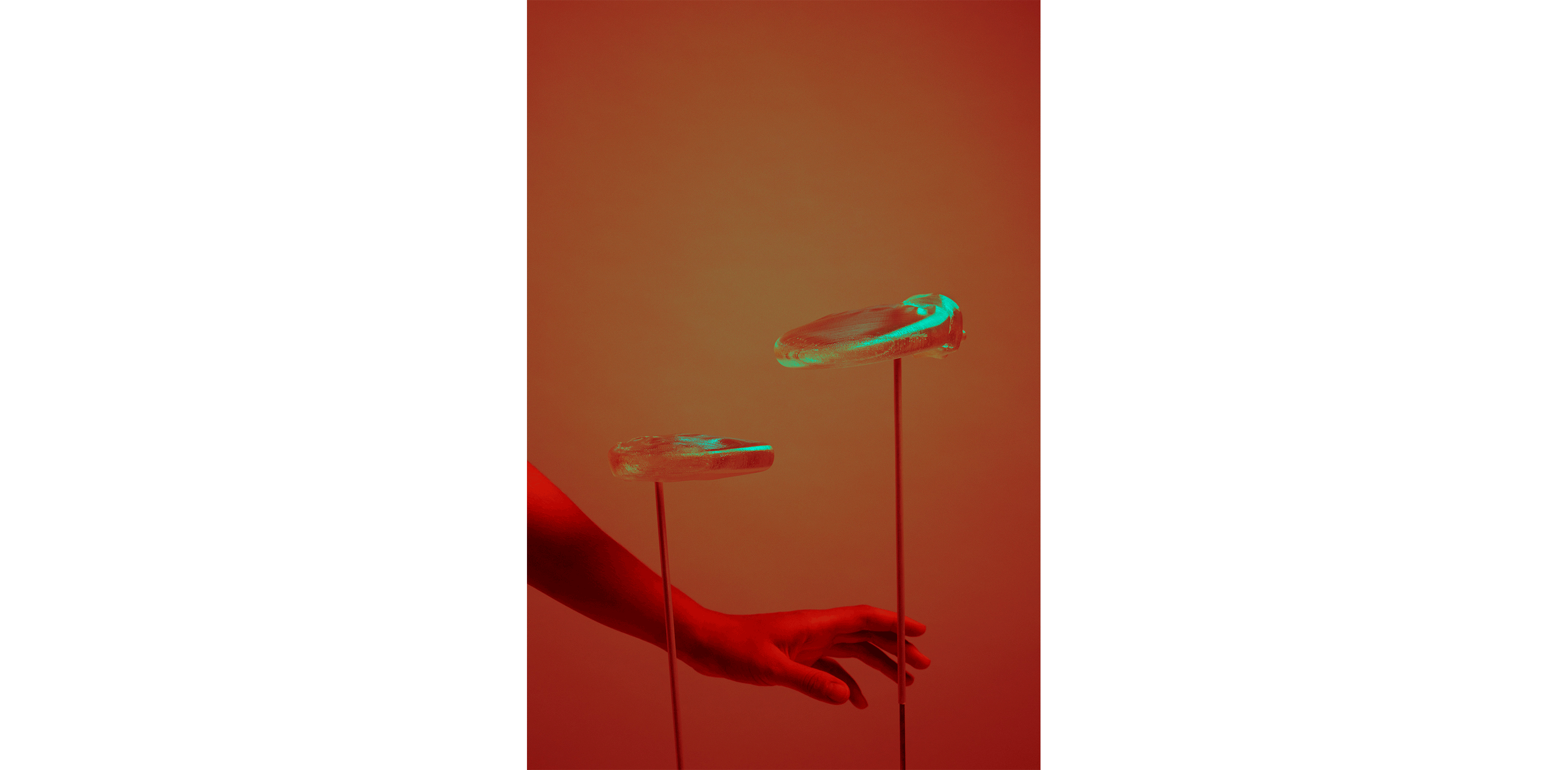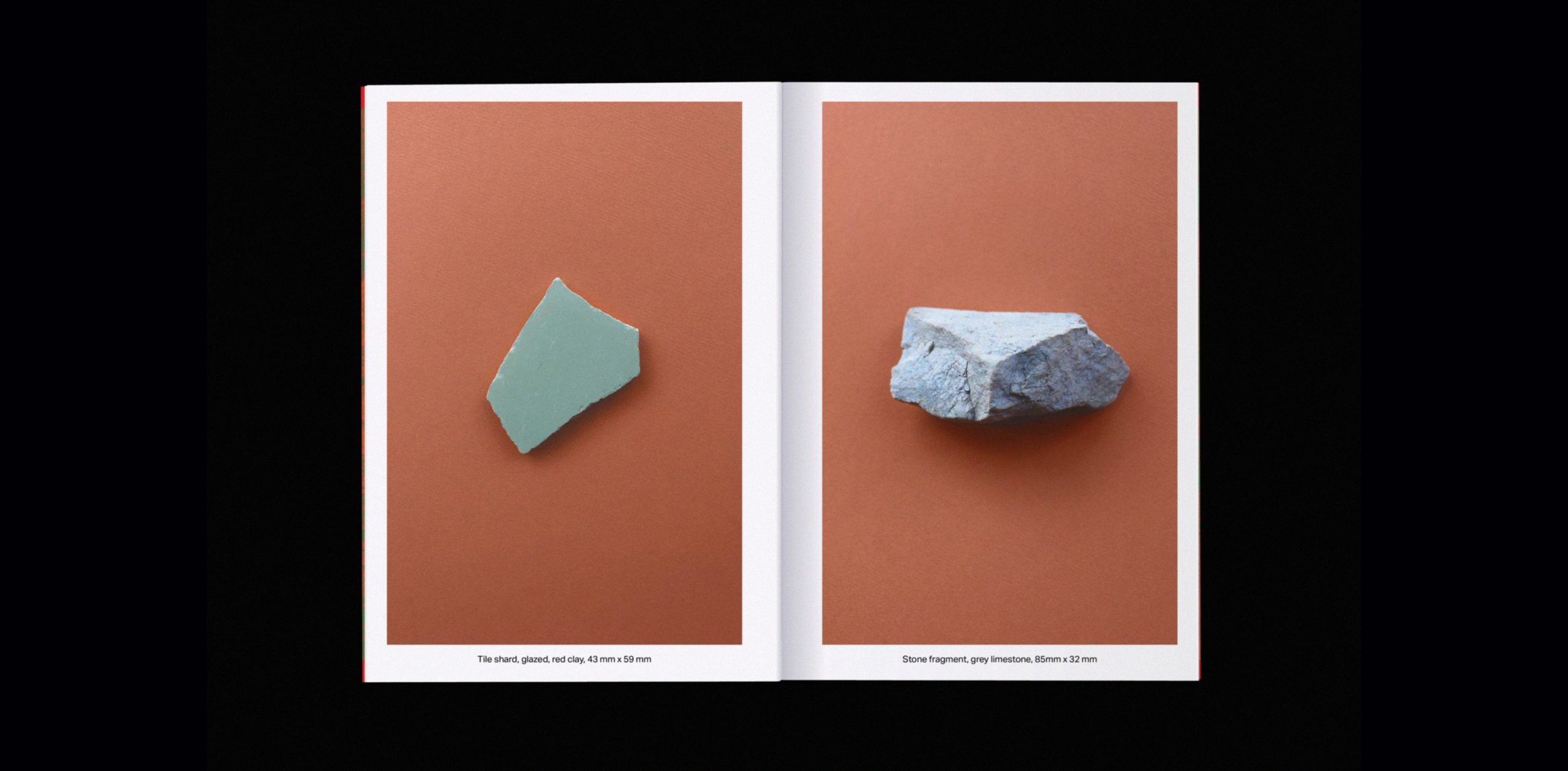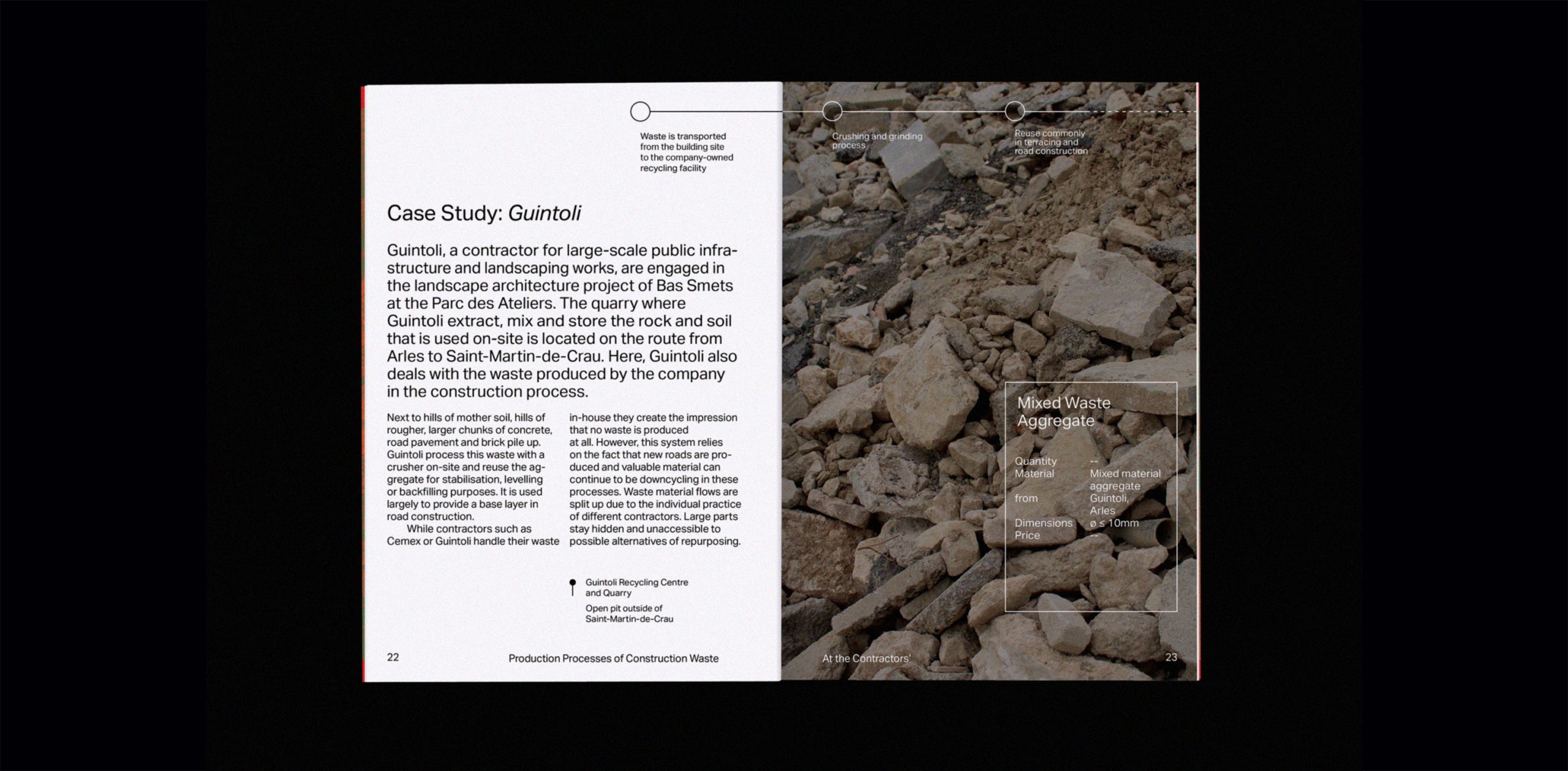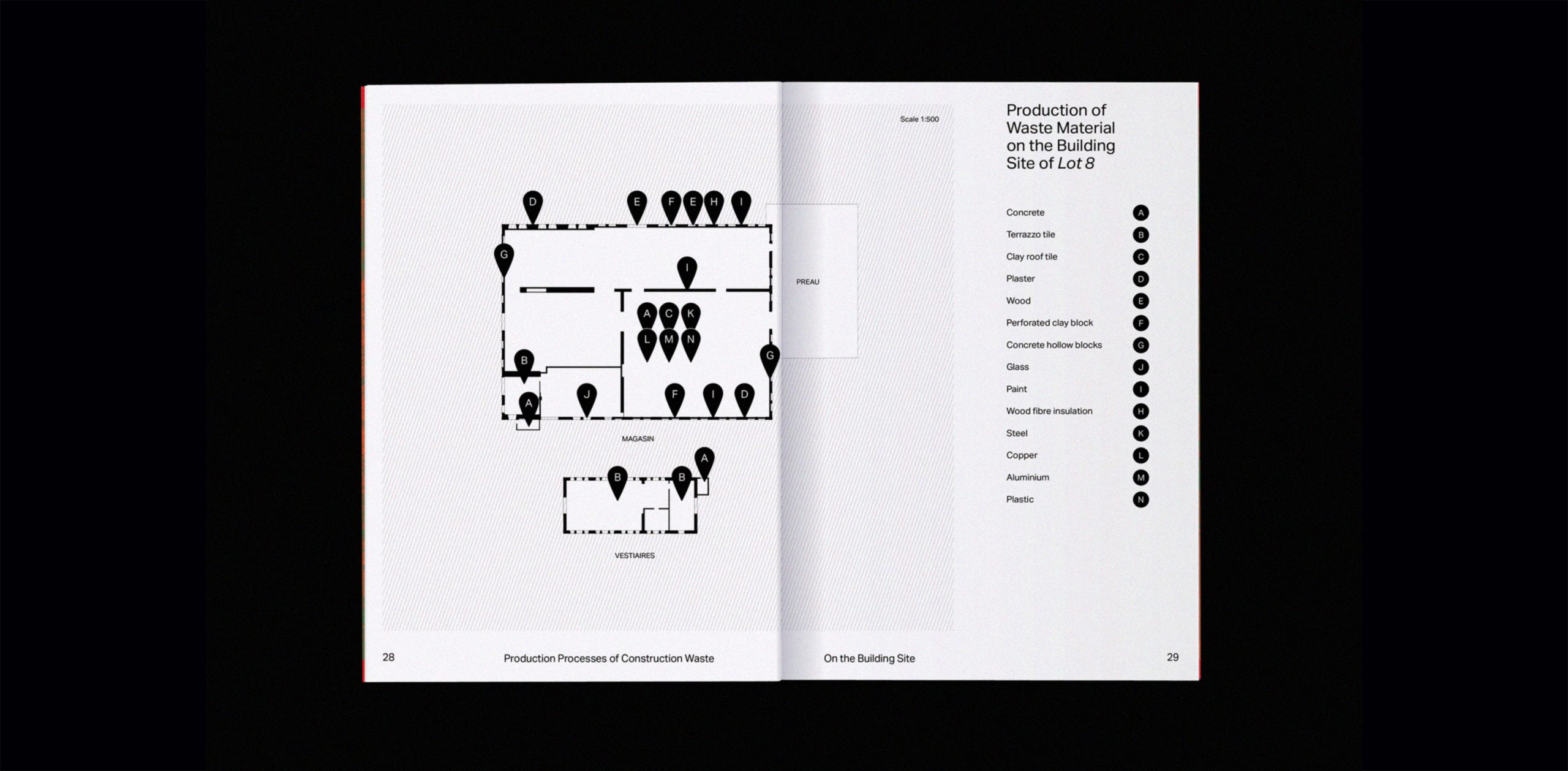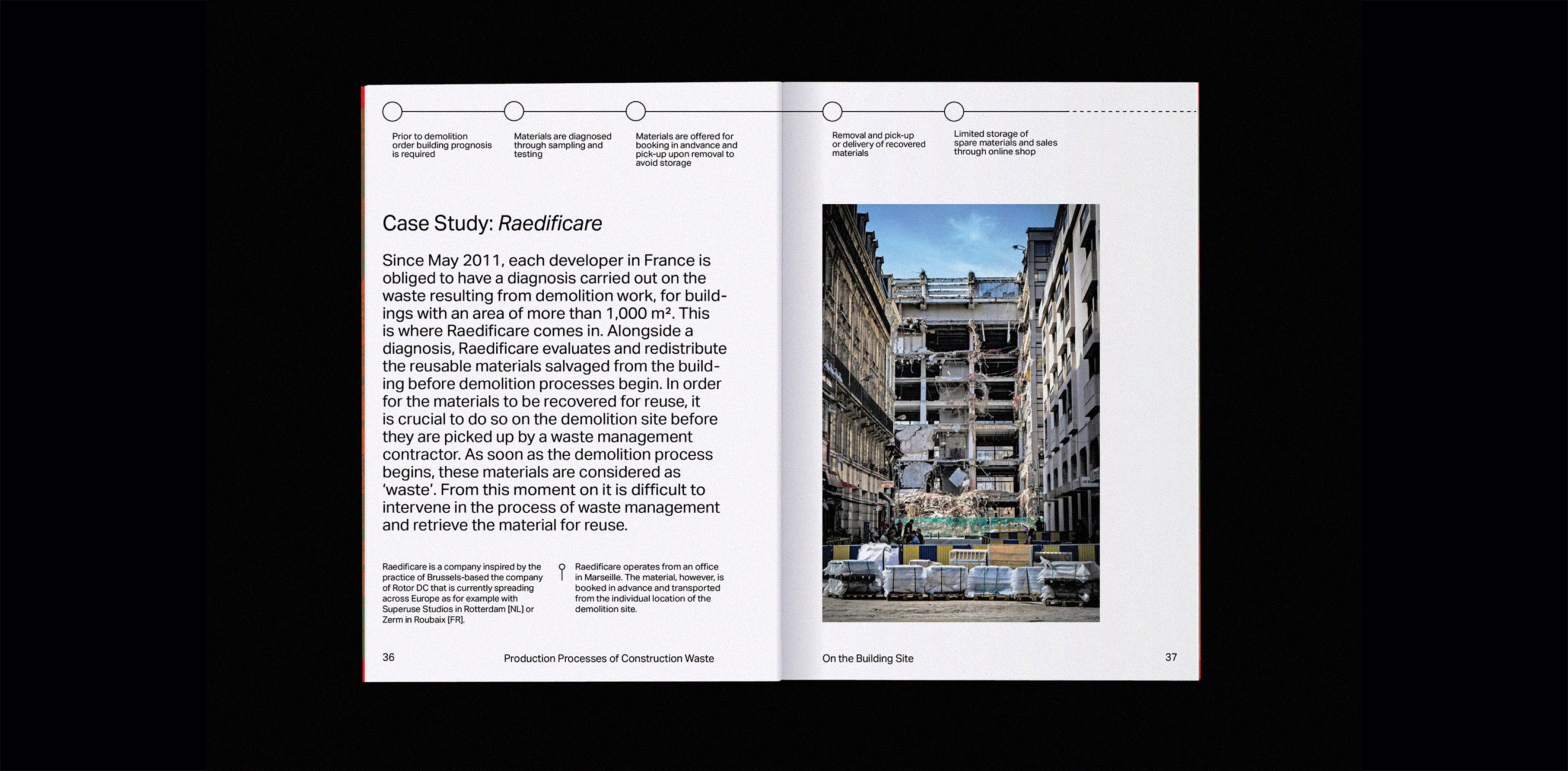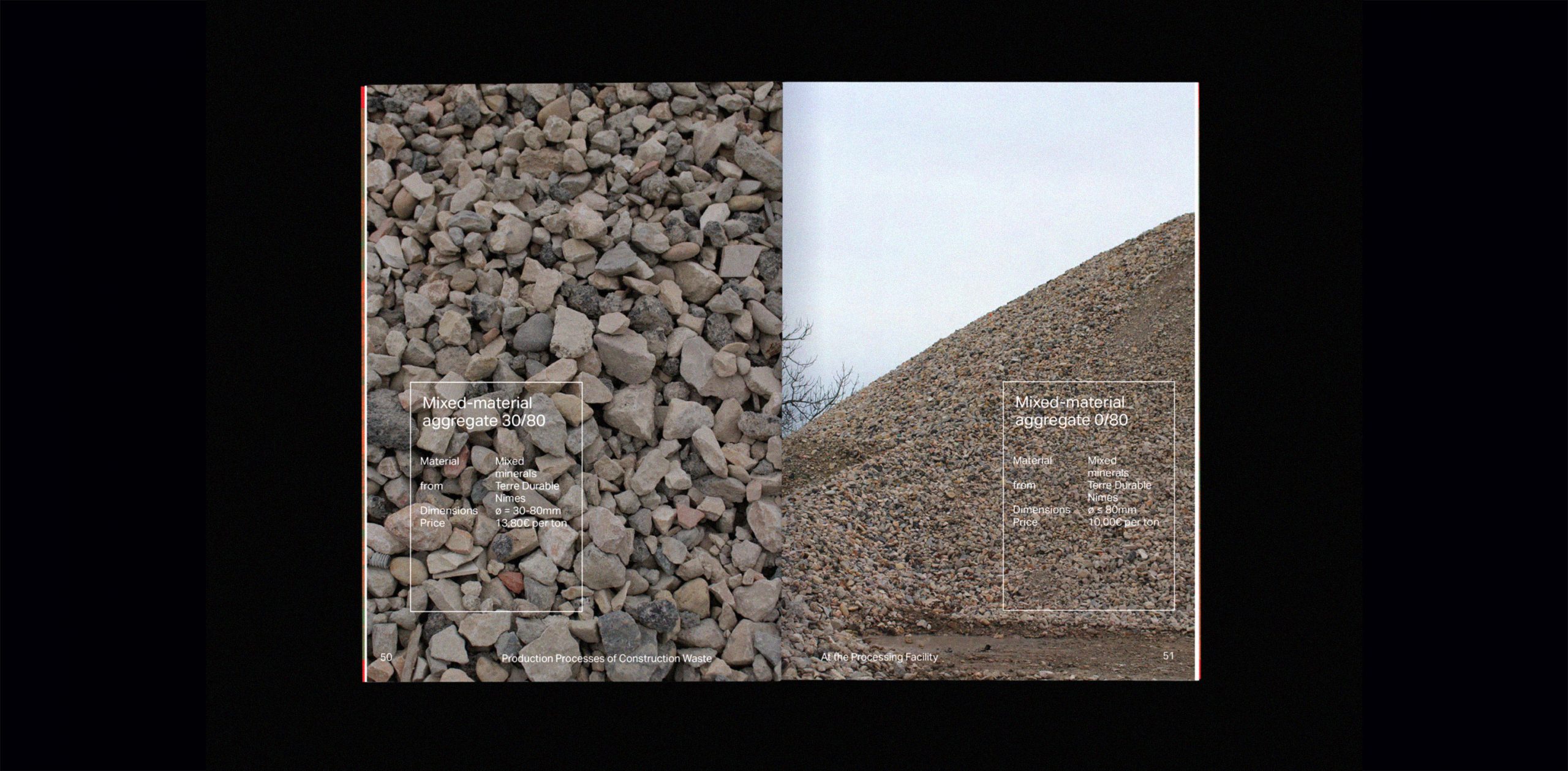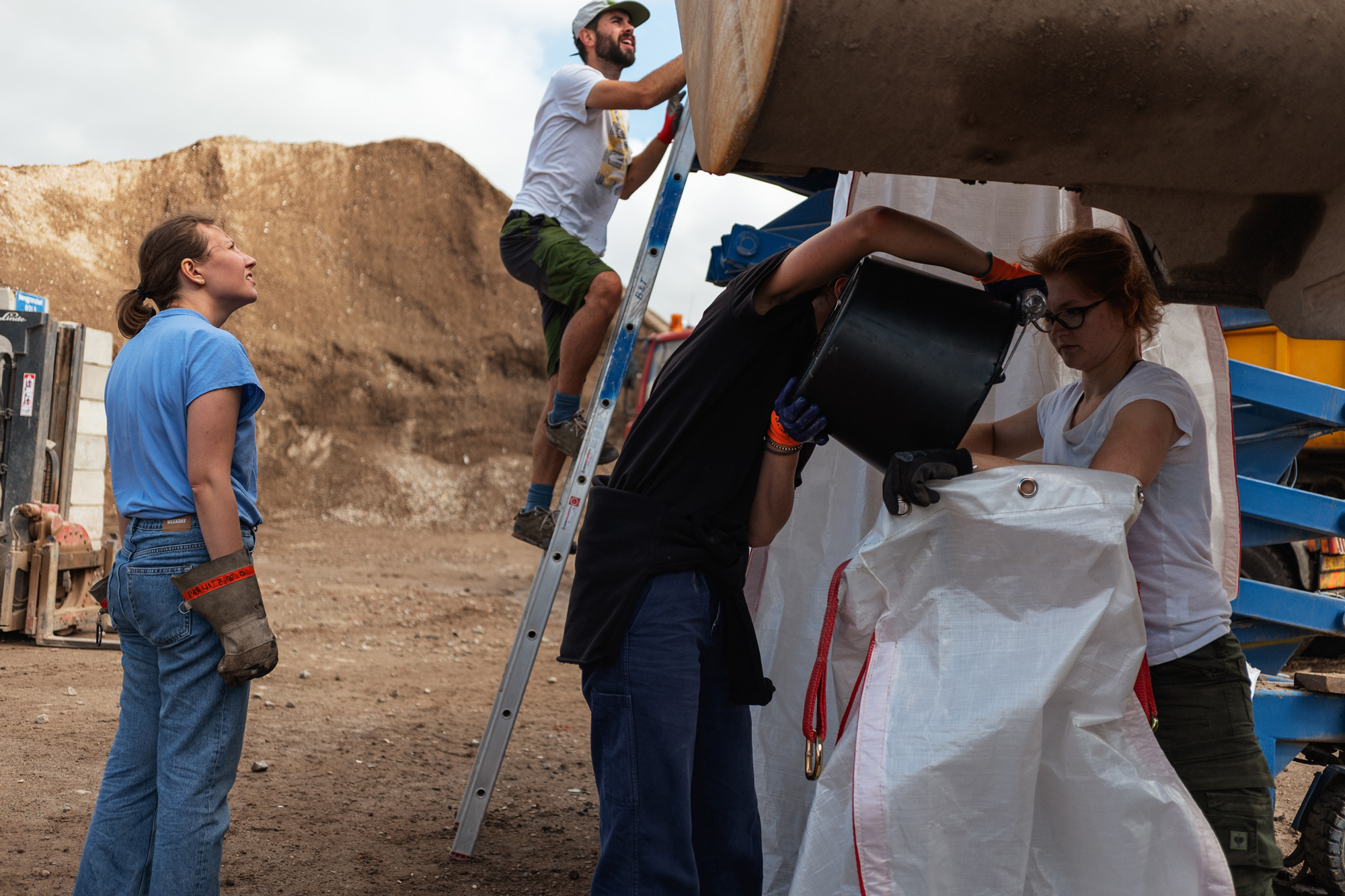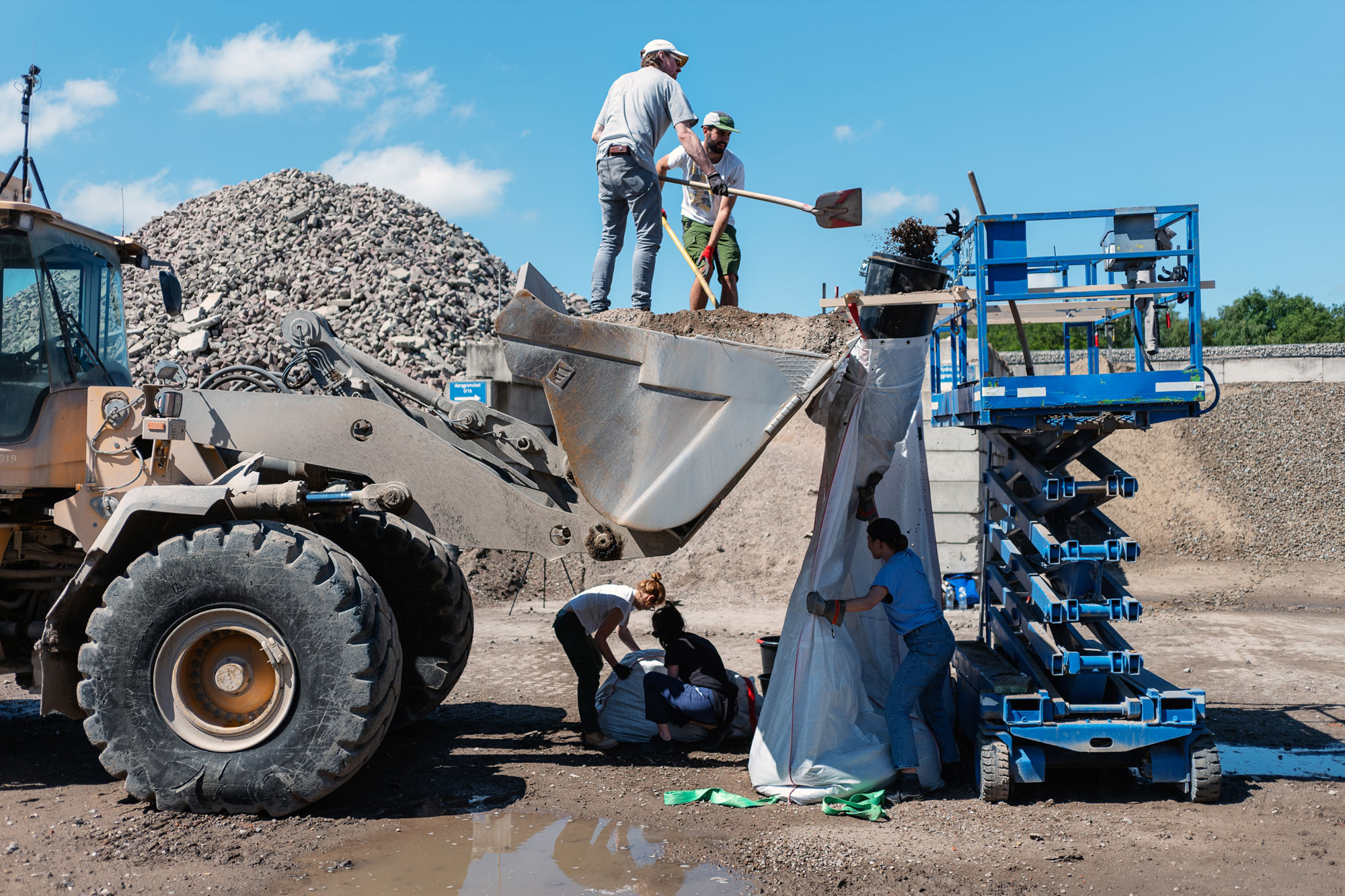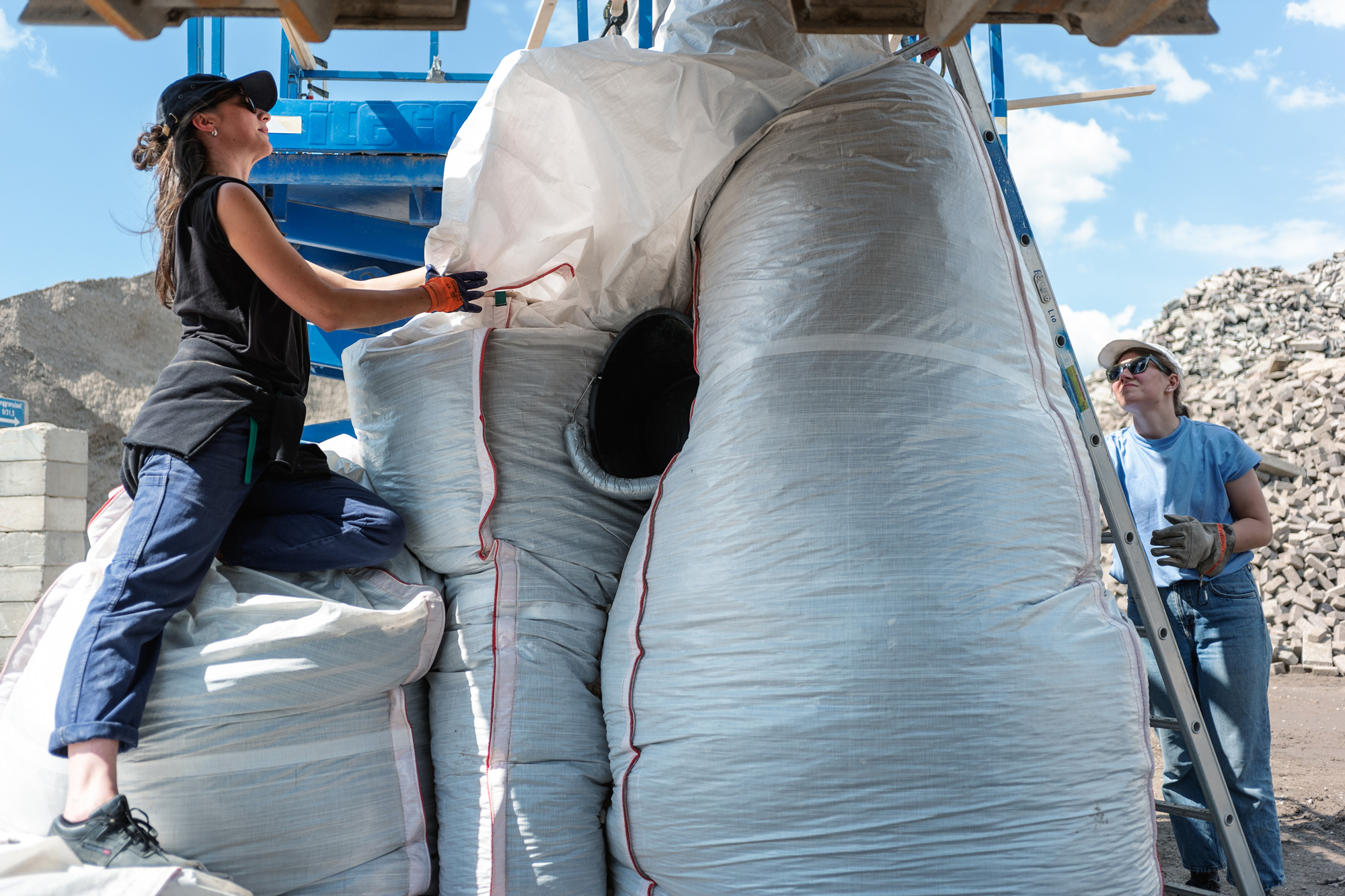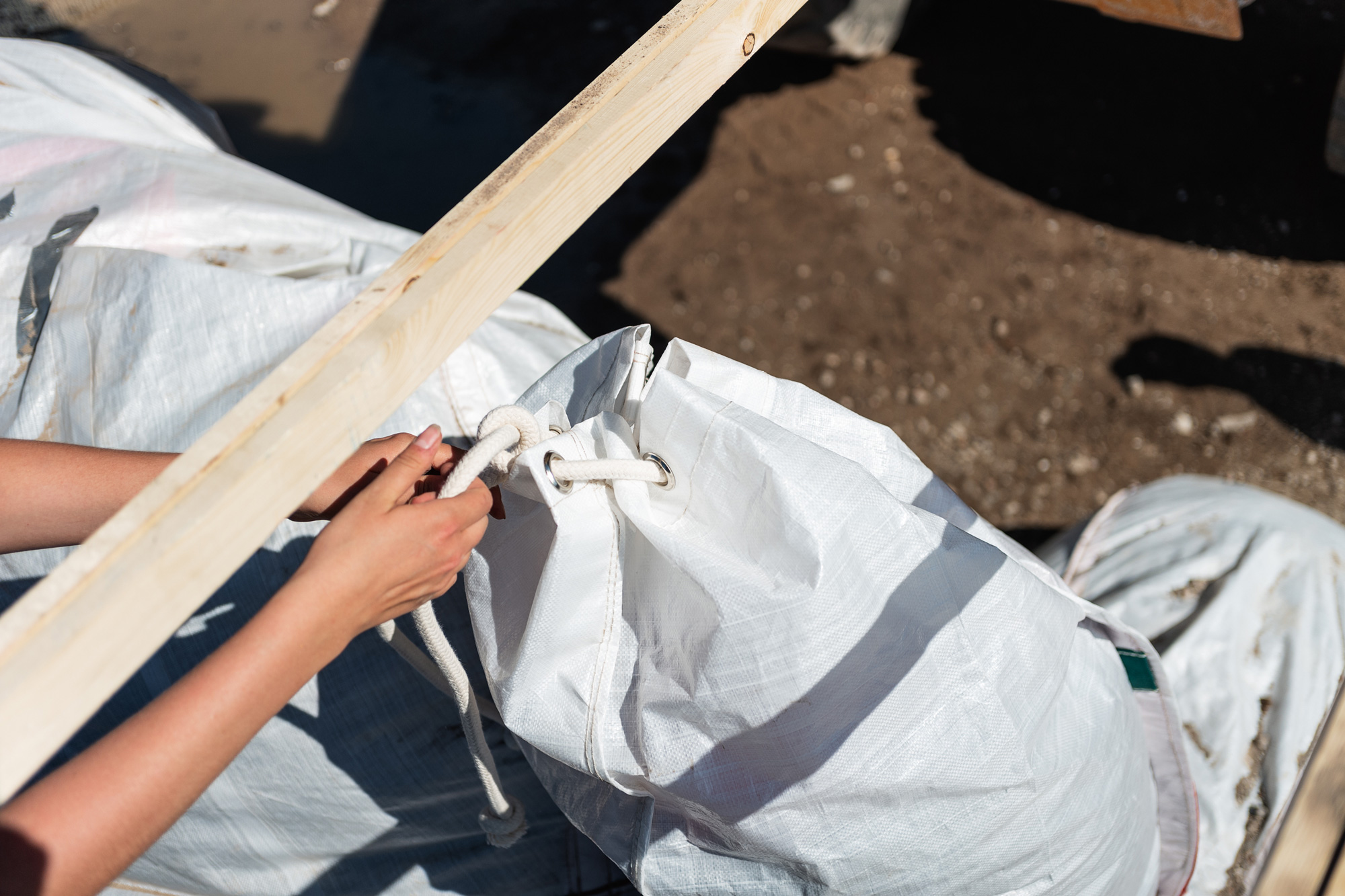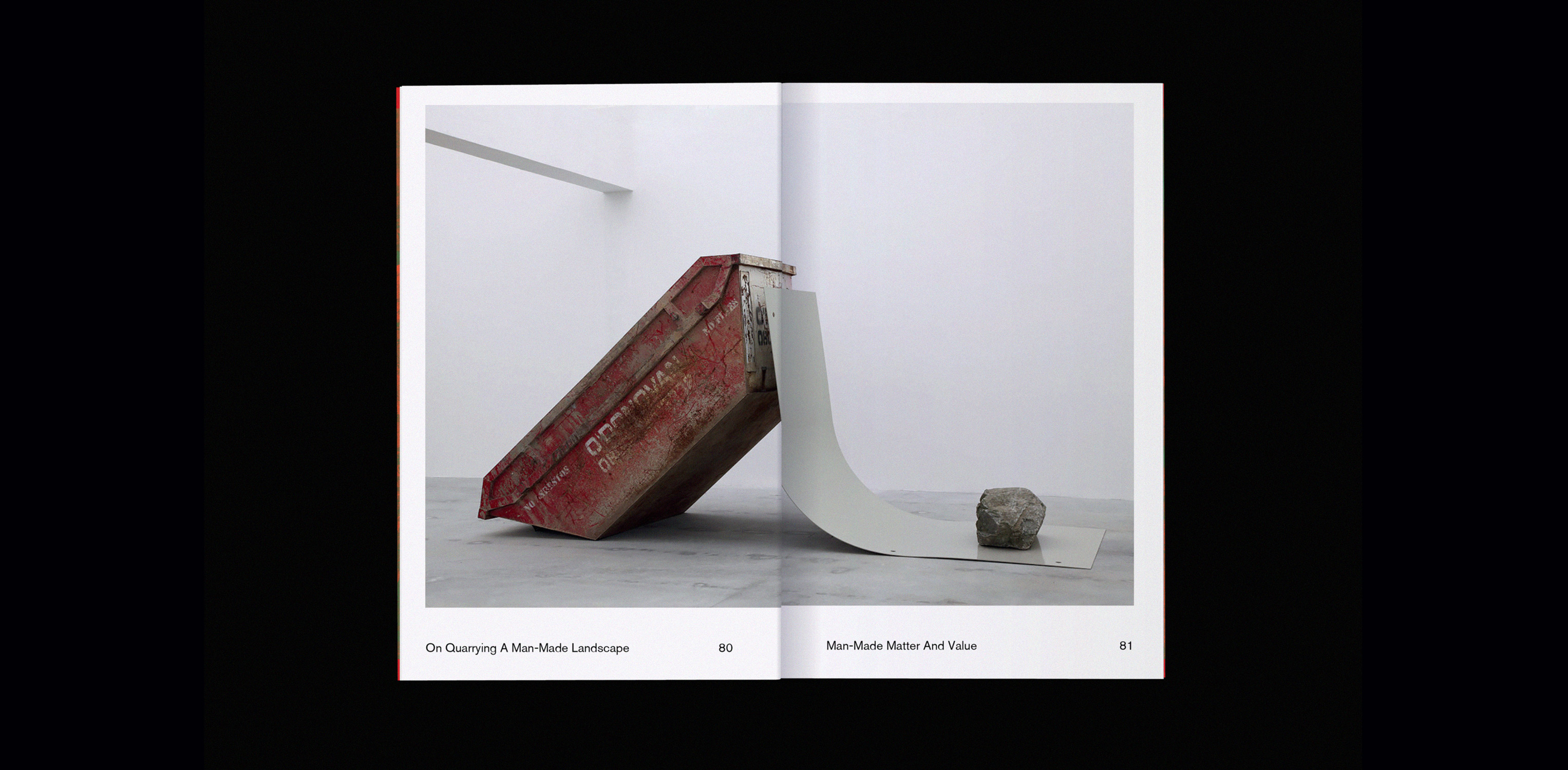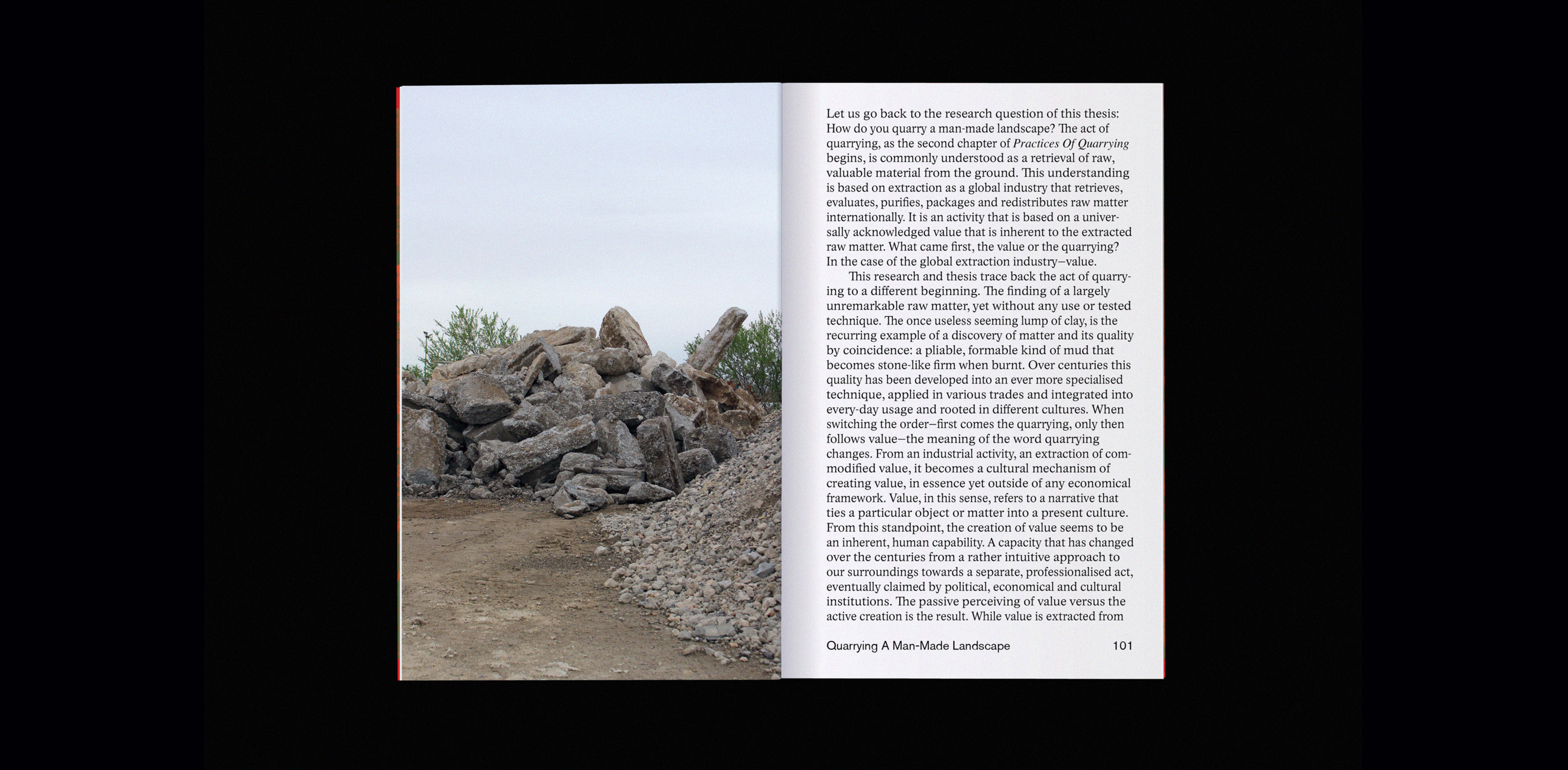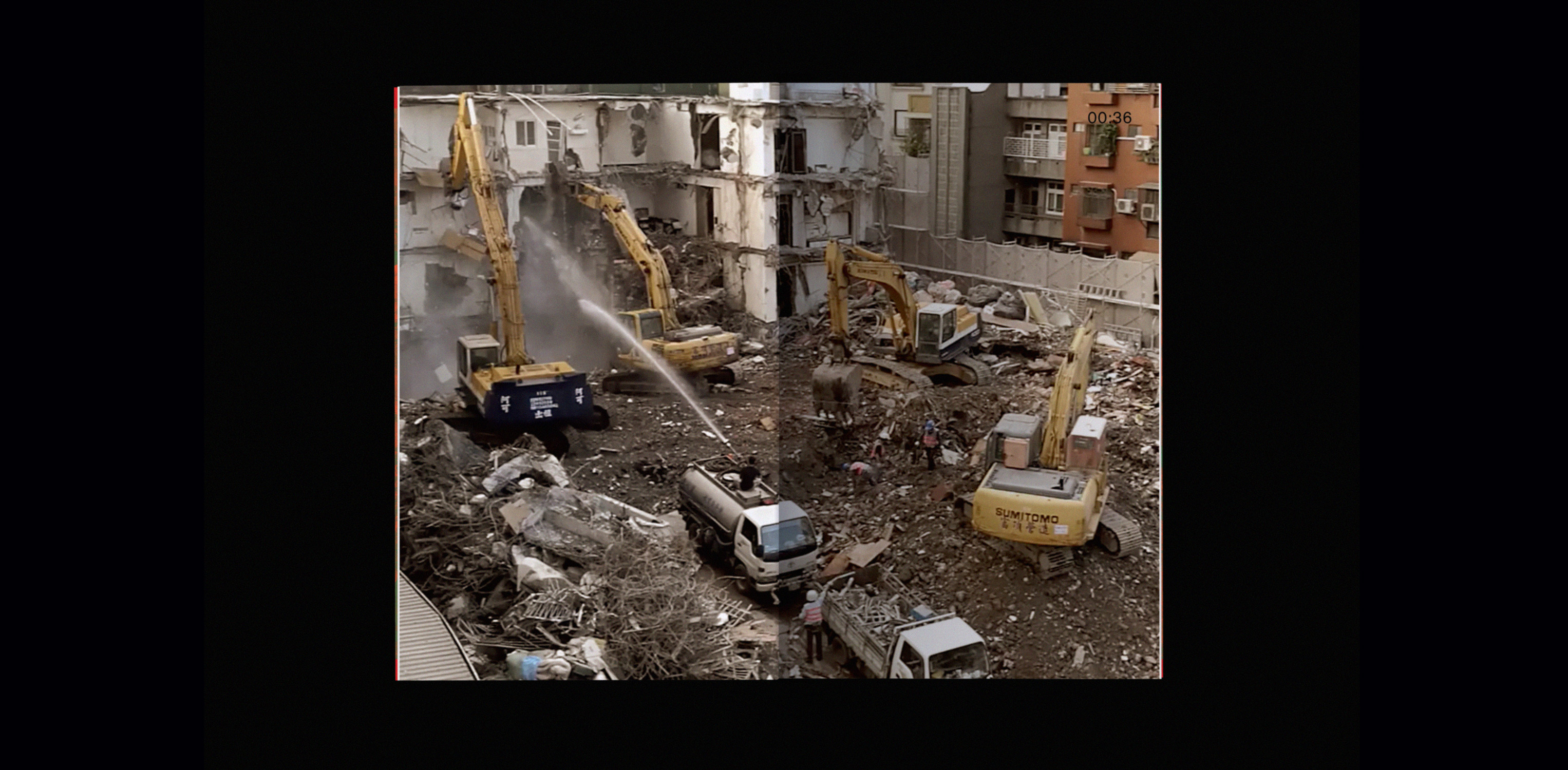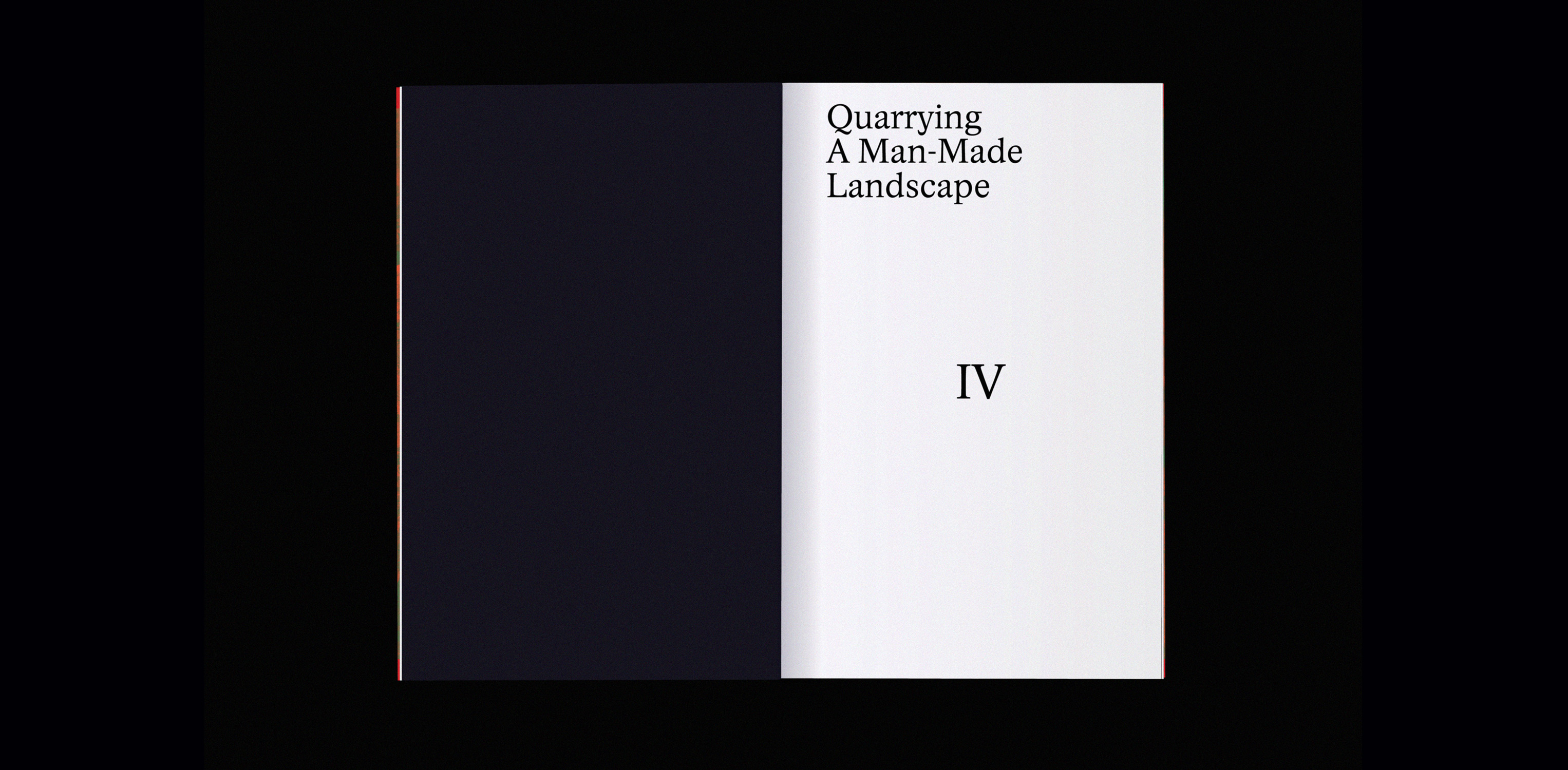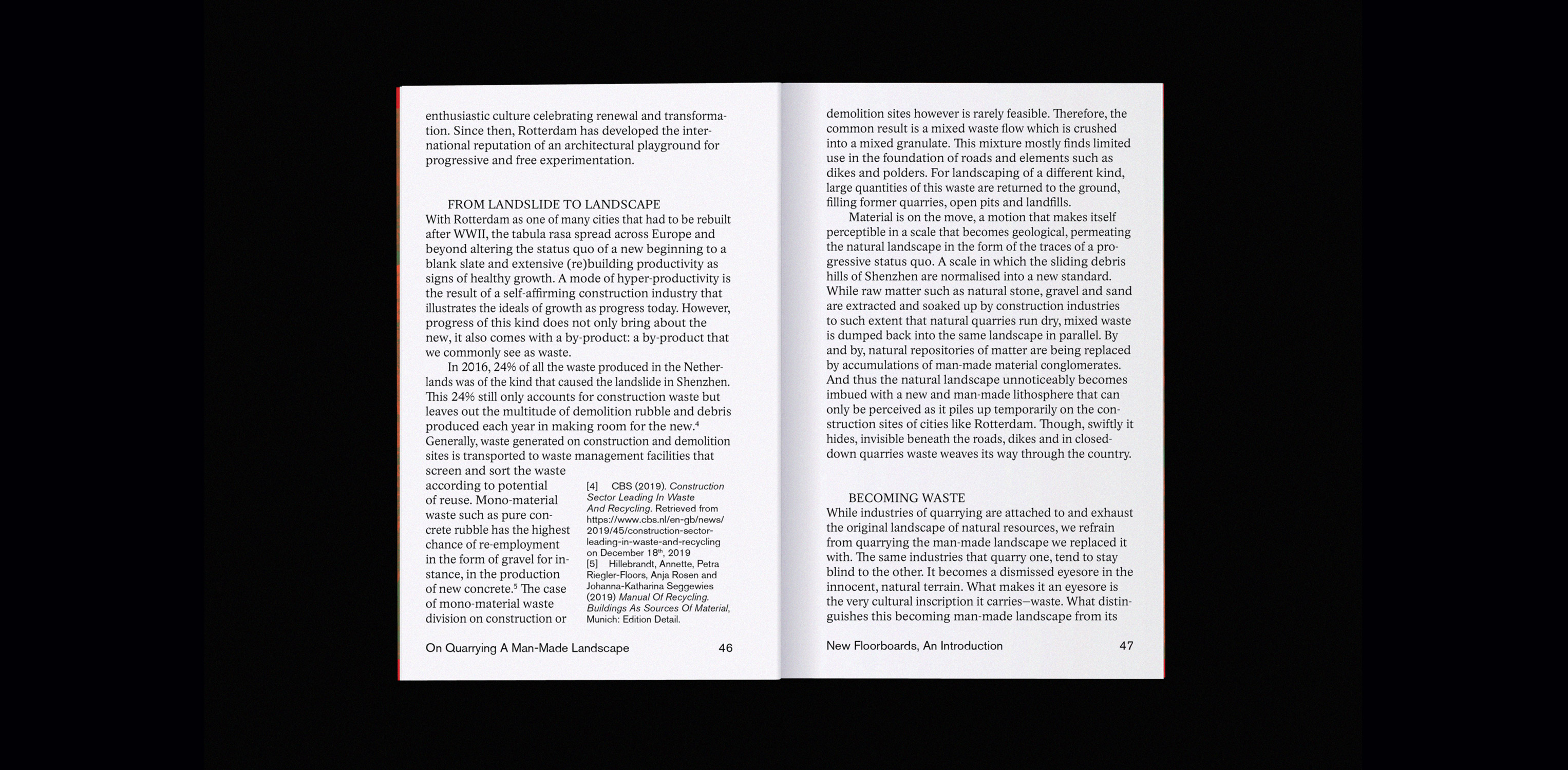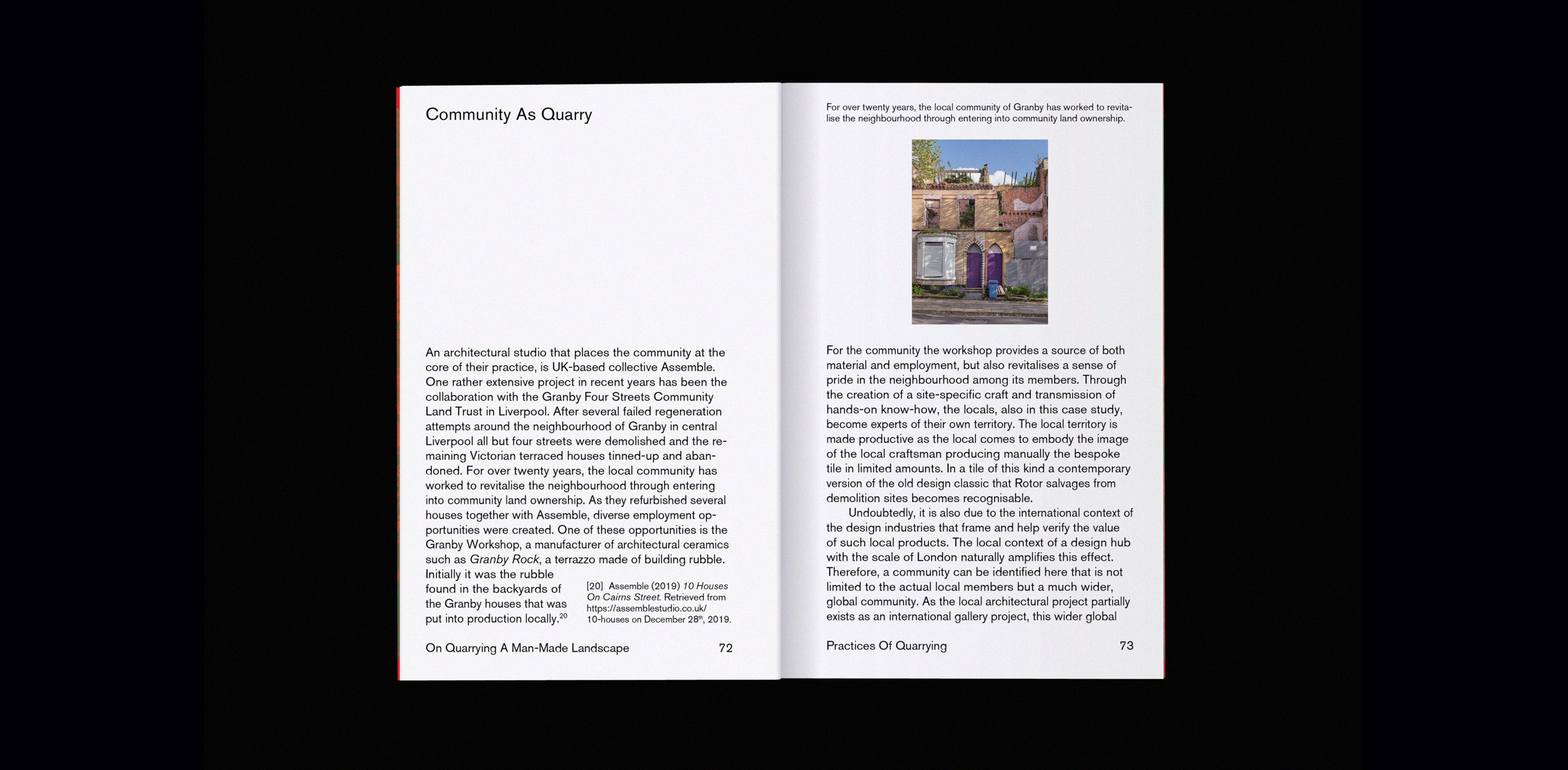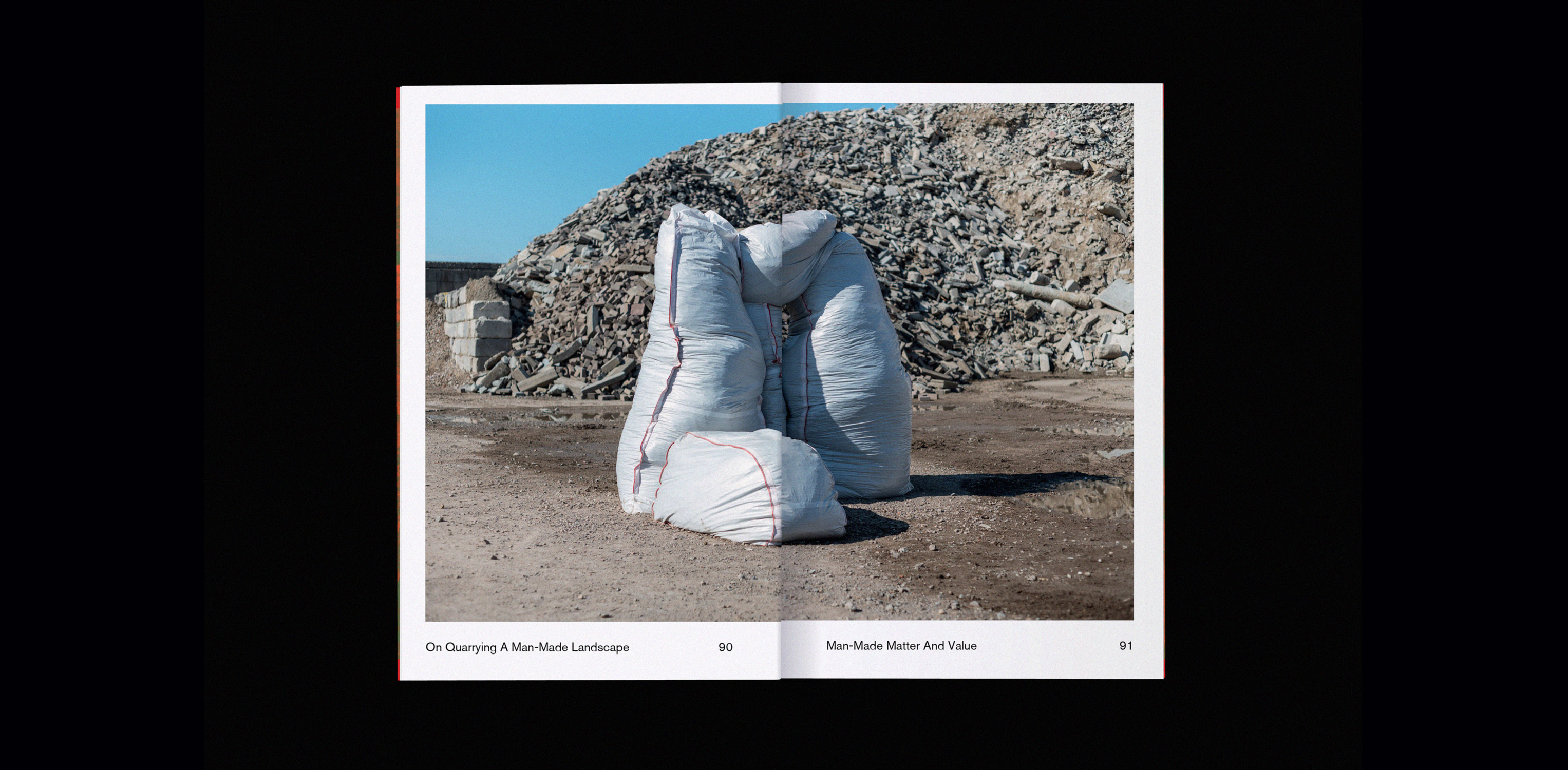Workshop Emerging Paths in Matera [IT], 2019
Through interviews with locals, international tourists and temporary residents that came to Matera for the duration of cultural capital, six students were guided in the mapping of the temporary transformations and permanent impacts as a result of the capital nomination. Conversations on temporary economical upswings, failed infrastructural redevelopments, homecomers introducing alternative usage to neglected buildings and new narratives forming around over-exposed as well as neglected cultural heritage are a few findings captured in form of a publication and a walking route connecting the changing landscapes of the ancient centre and sleepy periphery.
In response, 6 conversational pieces were built from tufo, the typical local sandstone, under guidance of craftsman Piero Giura Longo. While some put a focus on the changing territory through diverse means of carrying and body movement, others engage with achitectural key features through shape.
In form of a performative walk, these mobile artefacts were carried and pushed along the mapped out path. The students guide immediate neighbours and other local participants with diverse backgrounds through the changing territory contextualising the changing conversations, debate and exchange among the participants.
The workshop Emerging Paths was directed to the Master students at DAE taking place in the summer break from Juli 06th–14th, 2019 at Open Design School Matera. The workshop was developed in collaboration with Roberta Di Cosmo, Edoardo Tedone and Matilde Losi and with participation of Alina Slup and Marek Glogowski.









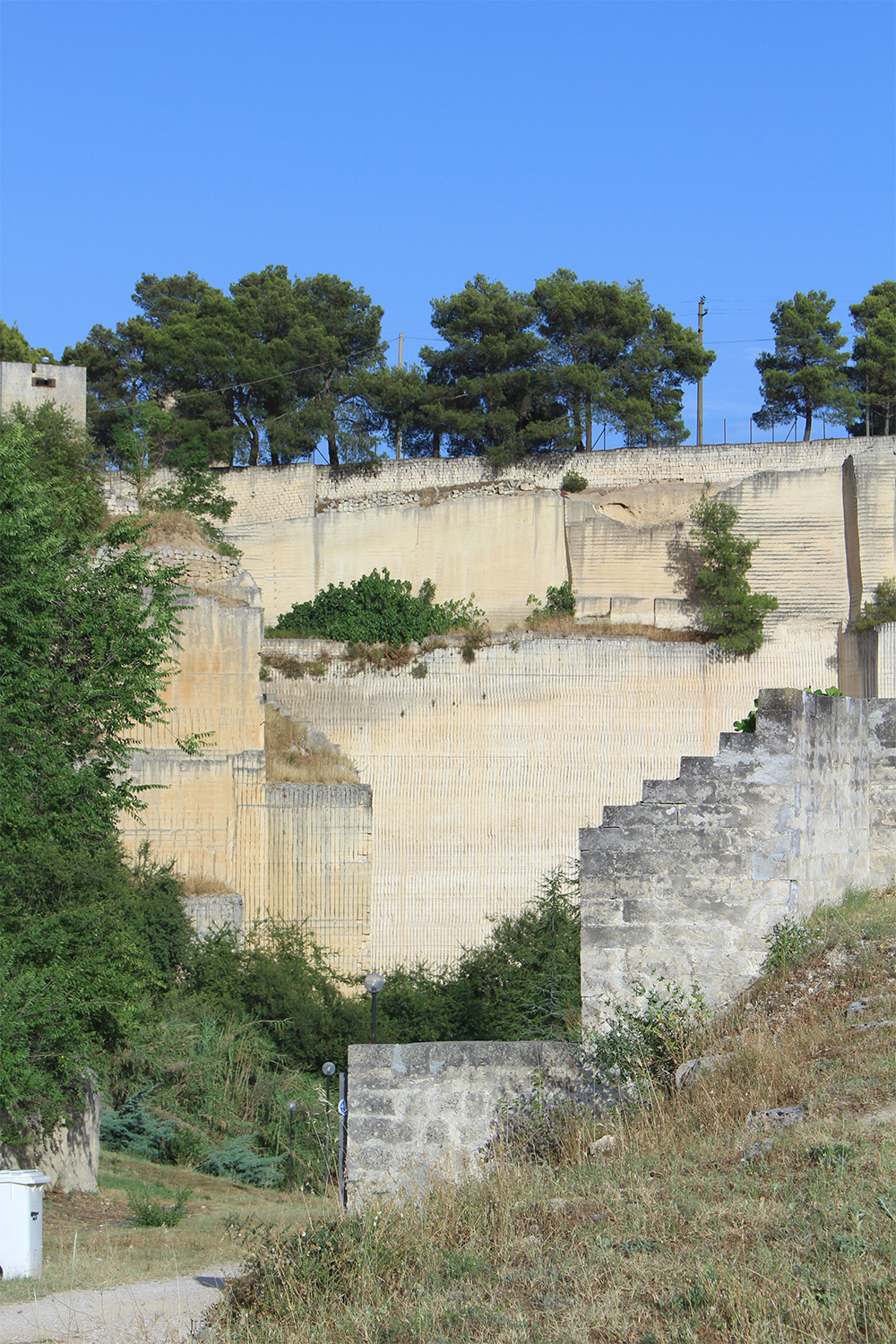
© Charly Blödel, 2022. For more Imprint.
Smails, A Ceramic Set
Part of the Letterhouse Series
The Letterhouse series is a collection of objects that translate the concept of manual letter-writing as a decelerating and unpacking practice in the navigation of fast information.
Smails, along with a foldable writing-paper set and writing desk Raksti, translates this concept of ‘sorting information’ in this case into the language of ceramics. Through its connecting shape, the ceramic set encourages the user to stack the vessels: You stack the dishes and actively free space on the table surface and on your mind.
The Letterhouse series the a Bachelor project developed by Charly Blödel in the Communications design Bachelor department at the Hochschule Mainz in Germany in 2016. The ceramics for Smails were produced under guidance of ceramics tutor Rudite Jecabsone in Babite, Latvia.


»The writer has to write to himself simultaneously, as, through the letter, he will get acquainted with himself.«
Clemens Brentano

© Charly Blödel, 2022. For more Imprint.
You will not be
A Performance and Installation part of
the Dutch Pavilion at the
XXII. Triennale Di Milano 2019
As the pace of our time becomes further assimilated into the 24/7-rhythm of the digital economy, a dizzying array of apps and gadgets are designed to optimise our intimate self according to the demands of the market. From therapeutic tools for sleep to attention- and anxiety-management, design is continuously mobilised to influence our day-to-day experience.
You will not be explores the destructive as well as the restorative capacities of these technologies, on the one hand, through the lens of its smooth interfaces and, on the other, the way these sculpt the body and its language today.
You will not be is a performance and digital installation developed from the design research project A Glossary of Darkness with mentors Angela Rui and Anastasia Kubrak resulting in the participation of the 1st Year Social Design Master students in the Dutch Pavilion at the XXII. Triennale di Milano, March–September 2019 and exhibition I See That I See What You Don’t See at Het Niewe Instituut, Rotterdam, October–December, 2019.
You will not be was developed and performed by the students Alice Bardou, Charly Blödel, Bianca Carague, Roberta Di Cosmo, Coline Declef, Charlelie Flamant, Giulio Fuzzi, Jan-Micha Gamer, Anna Klara Oxholm Iversen, Liana Kuyumcuyan, Coltrane Mcdowell, Matilde Patuelli, Victoria Plasteig, Marta Rioz Piza, Samein Shamsher and Alina Słup.As part of the participating student group, Charly Blödel took a representative role in the development of the concept, performance script, overall project management and contributed with an essay written in collaboration with Alice Bardou and Anna Klara Oxholm Iversen.

Digital installation of You will not be in the exhibition of the Dutch Pavilion at the XXII. Triennale di Milano

Digital installation of You will not be in the exhibition of the Dutch Pavilion at the XXII. Triennale di Milano

Performance of You will not be during the opening of the Dutch Pavilion at the XXII. Triennale di Milano (Photography: Daria Scagliola)

Digital installation of You will not be in the exhibition of the Dutch Pavilion at the XXII. Triennale di Milano

Performance of You will not be during the opening of the Dutch Pavilion at the XXII. Triennale di Milano (Photography: Daria Scagliola)

Digital installation of You will not be in the exhibition of the Dutch Pavilion at the XXII. Triennale di Milano

(Photography: Daria Scagliola)
© Charly Blödel, 2022. For more Imprint.
Seedless Fruit
We have tamed nature into our fields, domesticated it into our gardens, let it enter the urban landscape and the interior of our city homes. Now, how, — as we leave the permanent home, merge into a state of flux between temporary spaces of living, working, connecting — how do we render nature into the picture? Will it accompany us outside again to offer itself to us as we walk the street, pass through the metro station, catch the bus and pick, plug, harvest and enjoy the fruit of tomorrow?
Seedless Fruit is a series of artefacts containing shape studies in plaster merging existing fruit and vegetable types, documentation of harvesting postures and a 5-course meal to be harvested from designated food objects, and Seedless Fruit, the next generation of fruit designed on the basis of natural growth patterns and consumer data.
Seedless Fruit is a year-long design research project as part of the 100 Product for 2050 project with the tutors Eric Klarenbeek and Maartje Dros at DAE.

Analysis of natural growth and rotting processes of common fruit and vegetables

3D-printed Seedless Fruit, the next generation of fruit designed on the basis of natural growth patterns and consumer data

3D-printed Seedless Fruit, the next generation of fruit designed on the basis of natural growth patterns and consumer data

The Publication Seedless Fruit showing »Sea Salt Pastry layered with ceramic slabs« as part of the Food/Material Series that incorporates the picking and plugging moments of harvesting into a 5-course meal

Movements and body postures in the harvesting of different fruit and vegetable types

Shape studies in plaster merging existing, naturally grown fruit and vegetable typologies. (Photography by Niclas Ekwall)

Publication Seedless Fruit including a series of interviews with several local Dutch chefs on the topic of synthetic optimisation of food crops
»The melong is a fruit grown in 5 hours and 35 min- utes. Beginning from 1 to 2 a.m. in different time zones slightly varying due to their urban context, movement can be noticed on the drop-like nozzle tip of the stem. Descending from the ceiling of the tram stop, the manufacturing plant produces a soft-tex- tured blob. It fills with a juicy, fibred liquid, thicken- ing as it runs down the soft interior of the fruit.«
Excerpt from the publication Seedless Fruit

3D-printed Seedless Fruit, the next generation of fruit designed on the basis of natural growth patterns and consumer data

3D-printed Seedless Fruit, the next generation of fruit designed on the basis of natural growth patterns and consumer data

Publication Seedless Fruit giving an insight into the development towards the next generation of fruit tailored to meet improved efficiency and consumer data

The Publication Seedless Fruit showing »Baiser creme elevated on metal cloud« as part of the Food/Material Series that incorporates the picking and plugging moments of harvesting into a 5-course meal

The Desert »Dark Chocolate Splits Coating Flexible Acrylic Tubes« as part of the Food/Material Series that incorporates the picking and plugging moments of harvesting into a 5-course meal
© Charly Blödel, 2022. For more Imprint.
Rubble Probes—
Soft Rubble as a Building Process
The publication Rubble Probes explores Soft Rubble applied as a the construction system in the temporary contexts of the urban space in transformation. In form of spatial structures based on historical vernacular typologies, Soft Rubble becomes a tool for appropriation and activation as it inserts itself into the abandoned land plots or disused gaps found across Rotterdam. Assembled by the local neighbourhood by use of local building rubble, Rubble Probes become means to appropriate the temporary square adjacent to on-going construction sites, unused public spaces or as part of temporary cultural programming.
Rubble Probes is a collection of Rotterdam-based narratives of possible application of the textile construction system Soft Rubble. Soft Rubble is a master thesis project developed by Charly Blödel in the Social Design Department at the Design Academy Eindhoven in 2020.

»The Shelter«, based on the jardinu pantescu, the typical enclosed dry-wall gardens for single trees in Sicily




»The Cooler«, based on the yakhchal, the ancient ice pit developed by the Persions 400 BC to store ice in the desert




»The Pod«, based on the Sassi di Matera, the cave dwellings still inhabited today in the Southern Italian city of Matera



»The Windbreaker«, based on the cabane de camargue, rounded, reet-thatched houses positioned in direction to withstand the strong Mistral winds in the Camargue region of France
© Charly Blödel, 2022. For more Imprint.
Essay
The Contemporary Ruin — Material Frictions in Times of Flux
Material studies of material left-overs found in construction containers

WET WALLS
As fortunate as he was to work together with the grand master of modernism, Chilean painter Roberto Matta could not help but disagree with the principles of Le Corbusier. Working as a draftsman in Le Corbusier’s office, Matta rejected his idea of modern architecture as a fusion of the aspirations of classical renaissance architecture with the qualities of accelerating new technologies at the time. In the article of the surrealist magazine Minotaure1 he describes his contrasting ideals as “walls ‘like wet sheets that change shape to fit our psychological fears’, furnished with biomorphic couches that appear in his illustrations to mould to and at the same time threaten to swallow the human body”2. Matta describes his ideas of space as a flexible coat, almost fluid and imperceptible in its alignment with the human body. He portrays a synchronised relationship; two entities moving, intersecting, merging. An architecture rids itself from its material character, the essential “stuff it is made off” as opposed to the monumental and rigid qualities of Corbusier’s renaissance references. An architecture that shows no restraint in adjusting to the needs of its user producing the agility of different modes of usage.
Increasing shifts in the modes of usage of the built environment are a symptom of the continuous forward-facing motion of accelerating progress in our time. Socio-political and economic dynamics in society in the context of greater independence through digital connectivity fuel migrational movements around the globe. Yet, as bodies move at an increased rate, the spaces that they inhabit and leave behind accumulate in contrast to Matta’s scenario where they dematerialise and do not leave a trace3. In other words, the accelerated state of mind and body clash with the perceived ‘slowness’ of material which ultimately culminates in desertion and abandonment of buildings. In precisely this moment, the phenomenon of the contemporary ruin reveals itself. Our surrounding built environment expires much sooner4. It is continuously demolished, transformed, improved and readjusted, dressing the urban landscape in scaffolding. These disruptions tear the urban fabric and its interconnected social life that cannot be patched up as easily as it is dismantled. As these motions of building and removal accelerate, the term ‘ruin’ could receive new meanings: Can architecture only work or not work? Or could it actually be successful in its dysfunctionality? Put another way, could the ruin become productive?

This essay speculates on our relation to the contemporary ruin in the context of the accelerated times we find ourselves in. From the perspective of its static material presence in the fluid terrain of continuous progress it explores the productive potential and societal relevance of the friction that it carries. These accelerated times are what Hartmut Rosa identifies as conditions of ‘dynamic stabilisation’ through which we attempt to navigate the waves of progress.To achieve temporary stabilisation we feel required to push for constant growth, innovation and cultural reproduction of a status quo5. Upsurge of production and social change are the result. We experience these conditions as a feeling of accelerated time. This notion is vividly summarised by Douglas Coupland, co-author of The Age of Earthquakes: ‘The future for me, growing up, was always something that was ahead. In the distance–then it started to get closer. Then it was there, and now suddenly, right now actually is the future. What we’re inhabiting is no longer in the distance anymore but in this state of very, very profoundly accelerating flux.’6 With times in flux and progress inevitable, lifespans seem to become a questionable measurement, leaving the ruin in an ambiguous position.
Elaborating on the term ‘ruin’ words like “vestige”, “remnants”, “trace”, or “relic” come to mind, describing the idea of loss manifesting itself in the decaying traces of a failed utopia. The mere word, ‘ruin’, triggers nostalgia instantly and provokes the unquestioned response of preservation. Walter Benjamin’s definition of the ruin aligns with this notion in the sense that it is an object-trace capturing ‘nature in a petrified state to nature in a permanent state of transition’7. Nonetheless, Benjamin limits the value of the ruin to its documenting, capturing capacity and implies a need for maintaining this ‘petrified state’ to secure its meaning. This makes Benjamin’s ruin inaccessible as we have to keep a secure distance. By extension, it leads to the problematics of preservation—as we cannot sustain everything, what is worth keeping and who decides such matters?

ENDING POINT: SYSTEM
Dutch architectural firm OMA thematises the problematics of preservation in their masterplan for La Deféncein Paris. La Défense is one of the main business areas in Paris, that was bound to be expanded in 1991. As a proposal for this undertaking, OMA produced a scheme, causing a stir at the time, that rather than imposing another superstructure onto the dense area to focus on what lies beneath8. From the point of view of statistics, most of the current buildings would reach the end of their life span within the coming 20 to 30 years which would bring to light very naturally a tabula rasa, a blank slate, free of contextual conditioning. In anticipation of this emergence, OMA planned for the continuous revealing of an underlying grid that is the basis for not only the existing but also the extended areal of La Défense. In their proposal, they criticise that in Europe as “the Old World, the ‘continent of history’, there is an unspoken assumption that all its substance–even the most mediocre–is historic, and therefore has the right to eternal life.”9 “Mediocre substance” is what OMA’s masterplan categorises as recently erected buildings, doomed to imminent expiration and demolition or in other words—the contemporary ruin to be.
La Défense is a celebrated example of city planning. The role of the architect: patience. The elegant removal or “unbuilding”, is what Keller Easterling calls ‘perhaps the only subtraction project in recent memory that is prominent enough to be awarded a Pritzker equivalent for building removal’10. What her evaluation alludes to is that the existing buildings are acknowledged in their life cycles. Progress is registered as the driving force behind expiry and translated into a system bringing forward the new. Nonetheless, this system maintains the ruin clearly as an ending point. It restricts its potential to removal in order to unlock the possibility of a fresh start hidden underneath.
While Benjamin sees the value of the ruin in its preservation and OMA in its removal, an alternative that mediates between the two becomes very interesting, as both options are questionable in the face of global resource shortage and current carbon footprint of the building industry. So, how can we not merely cope with but take advantage of the material qualities of the ruin? How could the friction between the physicality of the expired building and our mind be a fruitful one? Svetlana Boym provides an insightful view of possible scenarios in her analysis of ruins. In her opinion, ruins do not only portray “a romanticising notion of the past layered with a contemporary reflection of our inner landscapes” but prove to be “sites for a new exploration and production of meanings”11. Boym lifts the heavy layer of dust. Interaction becomes possible and in this case crucial.

ENDING POINT: COMMUNITY
A project that makes use of building removal beyond the recovery of a blank slate, is A Way, Away [Listen While I Say]. The project taking place over several months in 2017 in St. Louis, Missouri, centred around the activation of an empty land plot and an adjoining building that would be demolished in the course of the project. Chicago-based artists Amanda Williams and Andres Hernandez choreographed the process of taking down the building as a community process in five phases of “Marking”, “Subtracting”, “Translating”, “Shaping”, and “Healing”12. The process was initiated by painting the complete building with golden paint to articulate the focus of the conversation. Throughout the documentation and retrieval of building materials from the demolition, the community made proposals and guided their use in the transformation into a green space for the city.
A Way, Away demonstrates how the ruin, given the time, can be opened up to a civic process to evaluate and formulate collective adaptation in a bottom-up manner when progress triggers urban transitioning and calls for new schemes. In engaging of the community throughout the process, Willians and Hernandez cultivated reflection and assessment of the life cycle of the urban landscape. However, in this case the developed conclusions were left without major impact on the previously planned park that eventually replaced the demolished building. The insights articulated meanwhile could not be channeled back into the planning process as the new plans had already been finalised.
Even though A Way, Away shows the potential of a ruin still in relation to its removal, it yields another insight. As a building is abandoned, it is removed from the market and the original financial envelope it initially emerged from. The ruin, as it has moved beyond the gaze of the market, does not have to function within its system of regulations anymore. In minimal periods of time, expired buildings can outline what is needed. Spaces are adjusted radically and rudimentarily to find quick solutions for temporary adjustments. In this sense, architecture takes the shape of a practice or performance as opposed to a scripted scheme. What seemingly lies in decay can become a 1:1 testing ground for conclusions such as the ones outlined by the community in St. Louis. This practice reminds of Matta’s image of ‘walls like wet sheets’ changing and morphing to the body’s motion With life re-entering into its deserted spaces, the ruin can be seen in a different light, posing the question: Could the ruin be reevaluated to be not seen as an ending point but become an actual starting point?

ENDING POINT: RUIN
Sans Souci Community Cinema in Soweto, South Africa shows what this notion could look like. In 1995, the Sans Souci Community Cinema was destroyed in a fire. In 2002, Lindsay Bremner and 26’10 South initiated its reconstruction through concept development from the spatiality of the ruin itself. Instead of speculating on the potential of the ruin, its capability to sustain a variety of functions was rendered tangible through open-air screenings, installations, performances, workshops and festivals13. This way the transformation was envisioned on-site, anchoring the future building at the heart of its community. Furthermore, the programme helped promote and raise a budget for reconstruction. Following a very successful campaign and further developments in the realisation of the generated proposal, heavy rainfalls led to the partial collapse of the remains of the building.
Nonetheless, the project is a strong case study for the ruin activated as a testing ground. In this sense, Sans Souci Cinema shows that the ruin today can exceed the role of “new exploration and production of meaning” (Boym) which remains on the theoretical level. It has the capacity to metamorph from an ending point of a life cycle into a starting point for the transformation of urban texture within specific local contexts.

RUIN AS NAVIGATION
OMA’s scheme for La Défense stopped at defining that buildings have shortening lifespans and applying this notion as a system. The project of A Way, Away shows how a community can be a driving force in the development of the built environment and foster a culture of engagement and initiative. Deconstruction becoming a civic process. Sans Souci Cinema develops this aspect further as the ruin then is transformed into a 1:1 testing ground to help reflect on past concepts to develop new ones. The ruin itself becomes a process. In this way, less defined areas in the regulated pattern of the urban landscape provide a fertile ground to become a thermometer of the relation between progress and inherent social change, emerging needs and necessary actions. Seeing the connections with buildings and how and why they do or do not work can let them have an influence and shape established architectural practices.
Now progress can be observed manifested on all scales throughout our daily paths and destinations. We see “with half-closed eyes, an accelerated time-lapse within which large swaths of building and landscape seem to be simultaneously cultivated and harvested or built and unbuilt”14, Keller Easterling describes. Yet buildings carry with them much more than the bare weight of their compiled building materials and are much harder to remove in concept as in practice. They do not decompose without a trace. They do not only answer to a grid that is drawn by an urban planner but also to the much more organic grid of appropriation by use of its community. Buildings, from their inception to their removal carry the stories that render the social tissue that holds and makes the built environment habitable.
The picture of ‘walls like wet sheets’ that Matta paints, seems to come very close to Easterling’s suggestion of ephemerality. Yet, the fluidity that he describes is of a different kind. It describes space that registers and is aware of the human being, is connected almost physically, lets itself be shaped and helps shape through productive friction. This fluidity asks for interaction, engagement and active shaping. From this perspective, the ruin moves beyond a mere milestone or an anchor point to navigate and position yourself against. The ruin is reconfigured from an endpoint into many possible new beginnings. As such, it can provide a fertile ground for cyclic motions of iteration, testing and evaluation on an urban scale. It can help form fluid, spatial narratives centered around an evolving ’social architecture’ as opposed to the remoteness and perceived slowness of conservative planning and construction practices. Positioned as such, the ruin gains a key role in the critical approach to, and navigation of continuous waves of progress in the extreme present.

1‘Mathématique sensible—Architecture du temps’, Minotaure, Paris, no.11, May 1938
2 Attlee, James (2007). Towards Anarchitecture: Gordon Matta-Clark and Le Corbusier. Retrieved from https://www.tate.org.uk/research/publications/tate-papers/07/towards-an-architecture-gordon-matta-clark-and-le-corbusier#foot- noteref26_a6tj2o5
3The notion of a tendency towards dematerialisation manifests itself in the continuous digitalisation of major parts of our lives, such as money through contactless payment, social interactions through digital networks, etc. yet hits firm limitations in the built environment. Our struggle with these limitation reveals itself on different levels such as the nomadic lifestyle being celebrated and articulated in the success of Airbnb, the home wherever you come to be, or the emergence of workspaces harnessing the creative, entrepreneurial industries all over the world. Furthermore, the need of space limited in time reveals itself in the extended application of cutting-edge technology such as large scale 3D-printing from bio-based materials such as the exhibition pavilions and cabins by DUS Architects such as the “Tiny [Bau]haus” stationed temporarily at Het Nieuwe Instituut in Rotterdam, The Netherlands. (See the website of DUS Architects here: https://houseofdus.com) The “Tiny [Bau]haus” is a cabin constructed from 3D-printed elements from bio-based plastics, creating a space that can easily be disposed of after travelling Europe for a year. (See the introduction to the Tiny [Bau]Haus on the website of HNI, Rotterdam here: https://neuhaus.hetnieuweinstituut.nl/curriculum/tiny-bauhaus)
4The term ‘expiry’ returns several times throughout the essay. What is meant by expiry is, that the building stops being used in the way or loses the context that it was initially planned for. Buildings today expire in their original purpose after around 20 to 30 years as described in OMA’s masterplan for La Défence that is discussed further along. (See OMA (2018). Mission Grand Axe. Retrieved from https://oma. eu/projects/missiongrandaxeladefense) Furthermore, the research of architect Jenny Bevan has shown that this estimated time until buildings generally expire continuously shortens. Each decade, we can expect the buildings that are being newly built to have a life span ten years shorter than the previous decade. (See Bevans TED Talk on “Our Disposable Architecture” here: https://www.youtube. com/watch?v=7OLsIvyFi8&t=60s&frags=pl%2Cwn) A curious thought, what will happen when the life span of a building in this sense moves into the negative from 2030 on.
5 Wajcman, Judy & Dodd, Nigel (2017) The Sociology of Speed. Oxford: Oxford University Press.
6Jones, Charlie R. (2015). Inside The Age of Earthquakes. Retrieved from https://www.dazeddigital.com/artsandculture/article/24283/1/inside-the-age-of-earthquakes
7Gómez Moya, Cristián (2011). Ruins. Retrieved from http://monumenttotransformation.org/atlas-of-transformation/html/r/ruins/ruins-cristian-gomez-moya.html
8OMA (2018). Mission Grand Axe. Retrieved from https://oma. eu/projects/missiongrandaxeladefense
9OMA (2018).
10Easterling, Keller (2014) Critical Practice 4, Subtraction. Berlin: Sternberg Press.
11Boym, Svetlana (2011). Ruinophilia: Appreciation of Ruins. Retrieved from http://monumenttotransformation.org/ atlas-of-transformation/html/r/ruinophilia/ruinophilia-apprecia- tionofruinssvetlanaboym.html
12 Fleischmann Brewer, Kristin (2017). Between Precarity and Possibility. Retrieved from https://www.awayaway.site/blog/betweenprecarityandpossibility
13Spatial Agency (–). Sans Souci Cinema. Retrieved from http://www.spatialagency.net/database/sans.souci.cinema
14Easterling, Keller (2014) Critical Practice 4, Subtraction. Berlin: Sternberg Press.
© Charly Blödel, 2022. For more Imprint.
Urban Quarries & Material Imaginaries,
An On-going Research Residency at
Atelier Luma, Arles [FR]
Production Processes of Construction Waste in Arles documents the preliminary research and mapping of building rubble in and around Arles. Construction waste is a material flow that occurs on diverse sites and in various mixtures. It is a material flow that is split up between these sites of production and entangled in the different frameworks of economic interest and policy.
This collection of processes gives an insight into the sites, circumstances and parties involved in the production of such mono-material and mixed-matter conglomerates. It provides a basis on which to question the conditions under which these conglomerates are produced and the systems that hold in place the concept of ‘waste’.

Terre Durable in Nîmes, a recycling facility, depo and supplier for crushed building waste



Hills of building waste integrating into the landscape

Part of the preliminary research was the mapping of building waste retrieved from one of the buildings part of the Luma Foundation that is currently under renovation.

The catalogue of quantified materials that are extracted during the renovation allows for the reemployment in custom-made materials for the new building.

Building rubble is a site-specific material that illustrates a local mixture of minerals. Due to Arles rich heritage as part of the Roman Empire, the local rubble contains a remarkable amounts of marble.

“Arles is the result of these early recycling patterns due to the nat- ural resource shortage inherent to Arles’s geographical location. It is a patchwork that has turned invisible on St. Trophine but certainly still recurs in the fragments of construc- tion waste that scarcely leave the historical centre yet present them- selves in pieces of marble among the common crushed concrete, clay tile and gravel on waste recycling sites such as the one of Terre Durable before they are filled back into the ground in road construction works or landscaping works.”
Excerpt from the essay ‘A Local Mixture’ in the publication

© Charly Blödel, 2022. For more Imprint.
Soft Rubble
Building rubble – one of the world’s largest waste streams – is mainly downcycled for the construction of roads, the backfilling of exhausted quarries and other landscaping processes. As the seemingly valueless material is filled back into the ground, the natural landscape we quarry to create it turns into a man-made landscape that stays untouched.
With Soft Rubble, Charly Blödel investigates mechanisms of value production and loss. In a performative build-up, textile containers made of Polyethylene sheet are filled manually with crushed rubble. This construction system can be filled and emptied repeatedly to create a variety of spatial configurations, becoming a tool to engage with the changing value of our material surroundings.
- PhotographyViktor Hübner
- ProductionZeilmakerij Van Doorn, Rotterdam
- Material Supply & Building SiteVan Berkel Bouwstoffen & Transport

The Western city exists in a state of hyper-productivity resulting in an imminent reproduction of the urban built environment. As a new building is erected, the previous is rendered obsolete. This swift exchange generates swaths of building waste. In 2015 alone, the city of Rotterdam produced 394.000 tons of building rubble. After being transported to a recycling facility this mixed-mineral waste is crushed and downcycled to filler material in landscaping and backfilling processes. Soft Rubble investigates mechanisms of both production and loss of value in the context of the fragile existence of raw matter on the verge of becoming mineral waste. It does so in the form of a construction process that positions building waste as building material.

To build the first prototype of Soft Rubble, 5 people filled 12 tons of building rubble into 4 bags in 8 hours.

The building team including Lisa Machemer, Charlélie Flamant, Matilde Losi, Daniel Parnitzke and Charly Blödel built the first prototype at Van Berkel Bouwstoffen & Transport, a building rubble recycling facility in Eindhoven on June 13th, 2020.

Soft Rubble is a tarpaulin construction system comprised of differently shaped textile containers made of 250g Polyethylene sheet. In a manual process, these reusable textile elements are filled with crushed building rubble to form rigid yet flexible stone walls. Any number of these containers can be combined and filled to create a variety of spatial configurations site-specific to local context and materiality. Preserving the porous material state of building rubble, Soft Rubble becomes a tool of activation to engage in both a physical and abstract manner with the changing value of our material surroundings.


The three-metre tall bags were produced by hand at Zeilmakerij Van Doorn in the Rotterdam Harbour.

Soft Rubble bags are made out of 250g Polyethylene sheet with nylon seams, reinforced with a polyester strap.
»While construction industries extract natural resources from the existing natural landscape in a process of gradual depletion, man-made material conglomerates are simultaneously reverted to the same landscape. As they are filled back into the ground, the natural landscape we quarry turns into a man-made landscape that stays untouched. Why do we quarry one landscape, while we stay blind to the other?«
Soft Rubble is a master thesis project developed in the Social Design Department at the Design Academy Eindhoven in 2020 with the support of the mentors Brecht Duijf , Stéphane Barbier Bouvet, Nadine Botha and Henriëtte Waal under the former head of department Jan Boelen.

On Quarrying A Man-Made Landscape is the written master thesis that accompanies the thesis project Soft Rubble.
© Charly Blödel, 2022. For more Imprint.
On Quarrying A Man-Made Landscape
The Western city exists in a state of hyper-productivity resulting in an imminent reproduction of the urban built environment. As a new building is erected, the previous is rendered obsolete. This swift exchange generates swaths of building waste. In 2015 alone, the city of Rotterdam produced 394.000 tons of building rubble. After being transported to a recycling facility this mixed-mineral waste is crushed and downcycled to filler material in landscaping and backfilling processes. On Quarrying A Man-Made Landscape investigates mechanisms of both production and loss of value in the context of the fragile existence of raw matter on the verge of becoming mineral waste. It does so in the form of a construction process that positions building waste as building material.
On Quarrying A Man-Made Landscape is a master thesis written by Charly Blödel in the Social Design Department at the Design Academy Eindhoven in 2020.

On Quarrying A Man-Made Landscape is the written master thesis that accompanies the thesis project Soft Rubble.
Abstract
The Western city portrays a state of hyper-productivity resulting in an imminent reproduction of the built environment that it inhabits. As a new building is erected, the previous is rendered obsolete. The swift exchange from use to disuse produces swaths of building debris that is being crushed and returned to the ground as a base layer in road construction or filler material for exhausted quarries and other landscaping purposes. While construction industries extract natural resources from the existing natural landscape in a process of gradual depletion, man-made material conglomerates are simultaneously reverted to the same landscape. As they are filled back into the ground, the natural landscape we quarry turns into a man-made landscape that stays untouched. What makes us avoid this other, man-made landscape is the mere ‘stuff’ that it is made of – waste.
How can we see this man-made landscape as a quarry and its material wealth as potential rather than waste? Tracing the condition under which raw matter can only become waste when framed as an industrial building material, waste is laid out as a social contract. Looking at the methodology of the three architectural practices of Rotor, BC Architects and Assemble, nostalgia is the strategy through which value is returned. Through the lens of the aforementioned practices, quarrying is outlined as a process of retrieval of raw matter, followed by the production of knowledge and affiliation with the local community, and eventually, its repeated usage becoming ritual. As such, the concept of quarrying reads as a local practice of creating value around the quarried matter rather than the industrial extraction of value as a pre-defined commodity.
Nonetheless, when nostalgia is utilised in the ‘re’-cycling, ‘re’-purposing, or ‘re’-use of waste, it is ultimately limited to a form of repair. Therefore, I argue that an alternative perception is required, a perspective that loses the ‘re’ and deviates from moving backwards towards the next level of progress. In this context, the concept of the quarry is evolved as a narrative practice that changes the perception of waste into the perception of a raw man-made matter as it produces new stories for a changing landscape. This potential is discussed in the context of my own work Soft Rubble that uses textile as a temporary binder to configure construction rubble to a free-standing, load-bearing textile wall.
© Charly Blödel, 2022. For more Imprint.
Soft Rubble
Building rubble – one of the world’s largest waste streams – is mainly downcycled for the construction of roads, the backfilling of exhausted quarries and other landscaping processes. As the seemingly valueless material is filled back into the ground, the natural landscape we quarry to create it turns into a man-made landscape that stays untouched.
With Soft Rubble, Charly Blödel investigates mechanisms of value production and loss. In a performative build-up, textile containers made of Polyethylene sheet are filled manually with crushed rubble. This construction system can be filled and emptied repeatedly to create a variety of spatial configurations, becoming a tool to engage with the changing value of our material surroundings.
- PhotographyViktor Hübner
- ProductionZeilmakerij Van Doorn, Rotterdam
- Material Supply & Building SiteVan Berkel Bouwstoffen & Transport

The Western city exists in a state of hyper-productivity resulting in an imminent reproduction of the urban built environment. As a new building is erected, the previous is rendered obsolete. This swift exchange generates swaths of building waste. In 2015 alone, the city of Rotterdam produced 394.000 tons of building rubble. After being transported to a recycling facility this mixed-mineral waste is crushed and downcycled to filler material in landscaping and backfilling processes. Soft Rubble investigates mechanisms of both production and loss of value in the context of the fragile existence of raw matter on the verge of becoming mineral waste. It does so in the form of a construction process that positions building waste as building material.

To build the first prototype of Soft Rubble, 5 people filled 12 tons of building rubble into 4 bags in 8 hours.

The building team including Lisa Machemer, Charlélie Flamant, Matilde Losi, Daniel Parnitzke and Charly Blödel built the first prototype at Van Berkel Bouwstoffen & Transport, a building rubble recycling facility in Eindhoven on June 13th, 2020.

Soft Rubble is a tarpaulin construction system comprised of differently shaped textile containers made of 250g Polyethylene sheet. In a manual process, these reusable textile elements are filled with crushed building rubble to form rigid yet flexible stone walls. Any number of these containers can be combined and filled to create a variety of spatial configurations site-specific to local context and materiality. Preserving the porous material state of building rubble, Soft Rubble becomes a tool of activation to engage in both a physical and abstract manner with the changing value of our material surroundings.


The three-metre tall bags were produced by hand at Zeilmakerij Van Doorn in the Rotterdam Harbour.

Soft Rubble bags are made out of 250g Polyethylene sheet with nylon seams, reinforced with a polyester strap.
»While construction industries extract natural resources from the existing natural landscape in a process of gradual depletion, man-made material conglomerates are simultaneously reverted to the same landscape. As they are filled back into the ground, the natural landscape we quarry turns into a man-made landscape that stays untouched. Why do we quarry one landscape, while we stay blind to the other?«
Soft Rubble is a master thesis project developed in the Social Design Department at the Design Academy Eindhoven in 2020 with the support of the mentors Brecht Duijf , Stéphane Barbier Bouvet, Nadine Botha and Henriëtte Waal under the former head of department Jan Boelen.

On Quarrying A Man-Made Landscape is the written master thesis that accompanies the thesis project Soft Rubble.
© Charly Blödel, 2022. For more Imprint.

